 |
From Beijing to Bangkok
five weeks overland through China, Laos and Thailand
Sept - Oct 2004
|
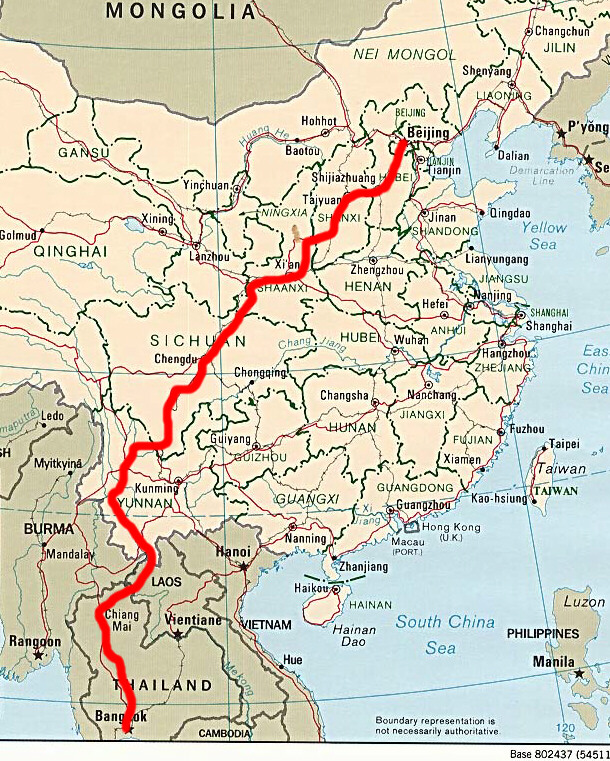
|
Beijing
|
Monday 27th September. We arrived in Beijing on time at 8:30 am. The visitor assistance people at the airport found a hotel for us which turned out to be in a perfect position - right in the middle of the 'hutongs', the old, winding alleys to the north of the 'Forbidden City'. The first night cost 260 Yuan (UK£18) but we negotiated 180Y per night for the rest of our stay. After dumping our belongings in the very basic hotel room we set off for the Laos Embassy to apply for visas, only to arrive five minutes after it closed for a 2½ hour lunch break! We stopped for a milk shake at a nearby café and then went to a couple of the large hotels up the road to enquire about tours - they quoted Y300 each for the standard Great Wall and Ming Tombs tour (so UK £21 at 14 Yuan = £1).
We had a huge bowl of beef stew/soup for lunch in the café of a big modern department store then returned to the Laos Embassy. We were the only people applying for visas and they seemed surprised to see us as we sat in the pleasant, airy front room writing out our application forms. Then we got a taxi back to our hotel and asked them about tours, and booked the same Great Wall and Ming Tomb tour (with English-speaking guide) for Y150, half the price of the other hotels. We went for a walk round the bustling old streets and through a market until a pedicab (cycle rickshaw) driver persuaded us to go for an hour's pedal round lake Houhai. It was a great way to travel but we nearly didn't get very far because several of the streets were jammed solid with traffic. Nobody will ever give way and they try to force their way through every jam, so often cars get completely stuck trying to get past an obstruction, then cycles will come and fill up all the available gaps until the street is completely occupied and nobody can move in any direction. After five or ten minutes of hooting and shouting things unblock and everybody lurches forward into the next jam. Eventually we pedalled free of the crowded south end of the lake and went lazily around the north end. It was a nice ride but of course the driver spoilt it by trying to claim that the price we'd agreed (Y70) was for each person instead of for the pedicab. We refused to pay any more and went off, and returned to a bar that we'd spotted near one of the traffic jams by Yin Ding bridge over the lake. We sat there and had beer and peanuts, watching the chaos. |
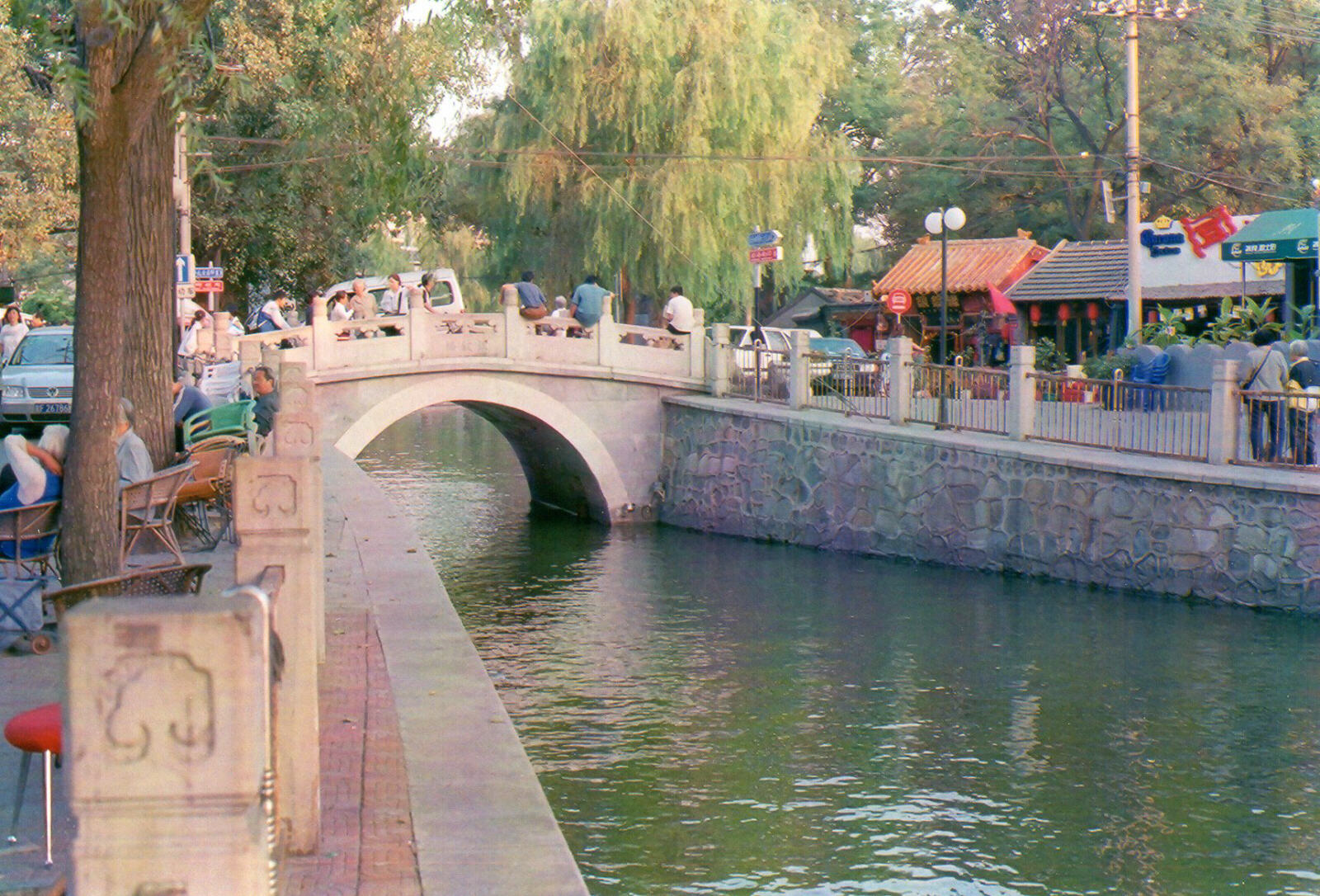
|
As we were walking back along MaoEr Hutong, one of the side streets, we noticed the 'Raj' Indian restaurant, so we stopped and had a really good Indian meal on the rooftop for Y140, including more beer.
Tues 28th. We went on the coach tour to the Ming Tombs and the Great Wall at Badaling. The road to our hotel was too small for the coach to come and pick us up, so they phoned and asked us to walk to the main road to meet them! The tour was one of the standard Great Wall tours that the local people do, and so everywhere was heaving with Chinese tourists, but this was part of the fun. Everyone was in little groups, following their guide with a flag on a pole, and of course all the guides had to shout to make themselves heard over the general hubbub, but thankfully we only saw one with an electric megaphone. The Ming Tomb was more impressive than we expected and the Great Wall was great fun. We didn't realise that you have to walk 3 km each way up and down incredibly steep slopes and steps to get to the 'highest point' (in this bit of wall, at least). All the Chinese tourists were very friendly and also unbelievably fit - there were ancient-looking people leaping up and down the steps while we were puffing and gasping. The Great Wall is not an easy, level walk. |
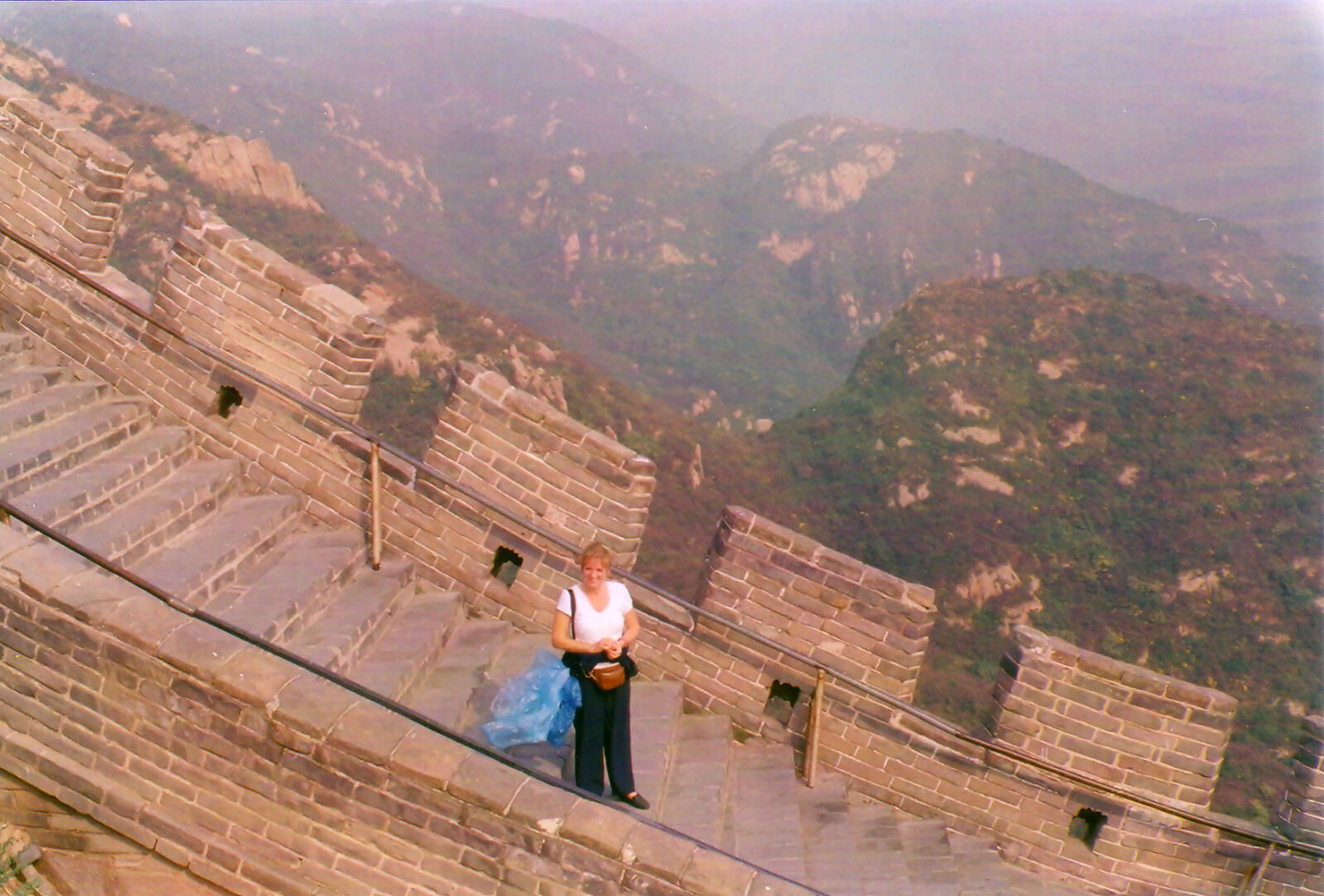
|
Of course, there was the obligatory stop at a jade factory during the tour, which was rather interesting with a few token workers cutting and polishing jade and some fantastic finished statues, and we also stopped at a Chinese medicine and herbs 'hospital' where, after a very short introductory talk on Chinese medicine, three 'professors' trooped in and proceeded to diagnose what was wrong with us and to prescribe some extremely expensive herbal medicines which none of us actually bought. We also had a nice Chinese lunch in what was billed as 'the largest restaurant in China' - a vast cavern of a place with hundreds of tables for hundreds of tour groups.
In the evening we went on what has become our standard promenade (we've only been here two days). We walked down the hutong, stopping at the market to buy peanuts (we got an extra scoop because he recognised us and felt bad about overcharging us yesterday). Then we had a couple of beers sitting on the sofa by the traffic chaos bridge, where again the bar owners were pleased to see we'd come back and made a big fuss of us, including giving us Moon Cakes for the Moon Festival which is in progress today, and giving us little Corona Beer badges with flashing lights to pin on ourselves! We had another super Indian meal at the Raj, but indoors this time because it was a cool evening, and staggered home down the hutong, exhausted after another full day (but not because of the alcohol content of the local beer, which is almost non-existent).
Weds 29th. We went for a walk, after dropping our dirty clothes off at the local laundry round the corner. We walked to Beihai Park, the former playground of the emperors, and climbed up to the White Pagoda for a view of the rooftops of the Forbidden City through the mist. Everything in the park was beautifully decorated with flowers and cleaned up for the forthcoming National Day celebrations. |
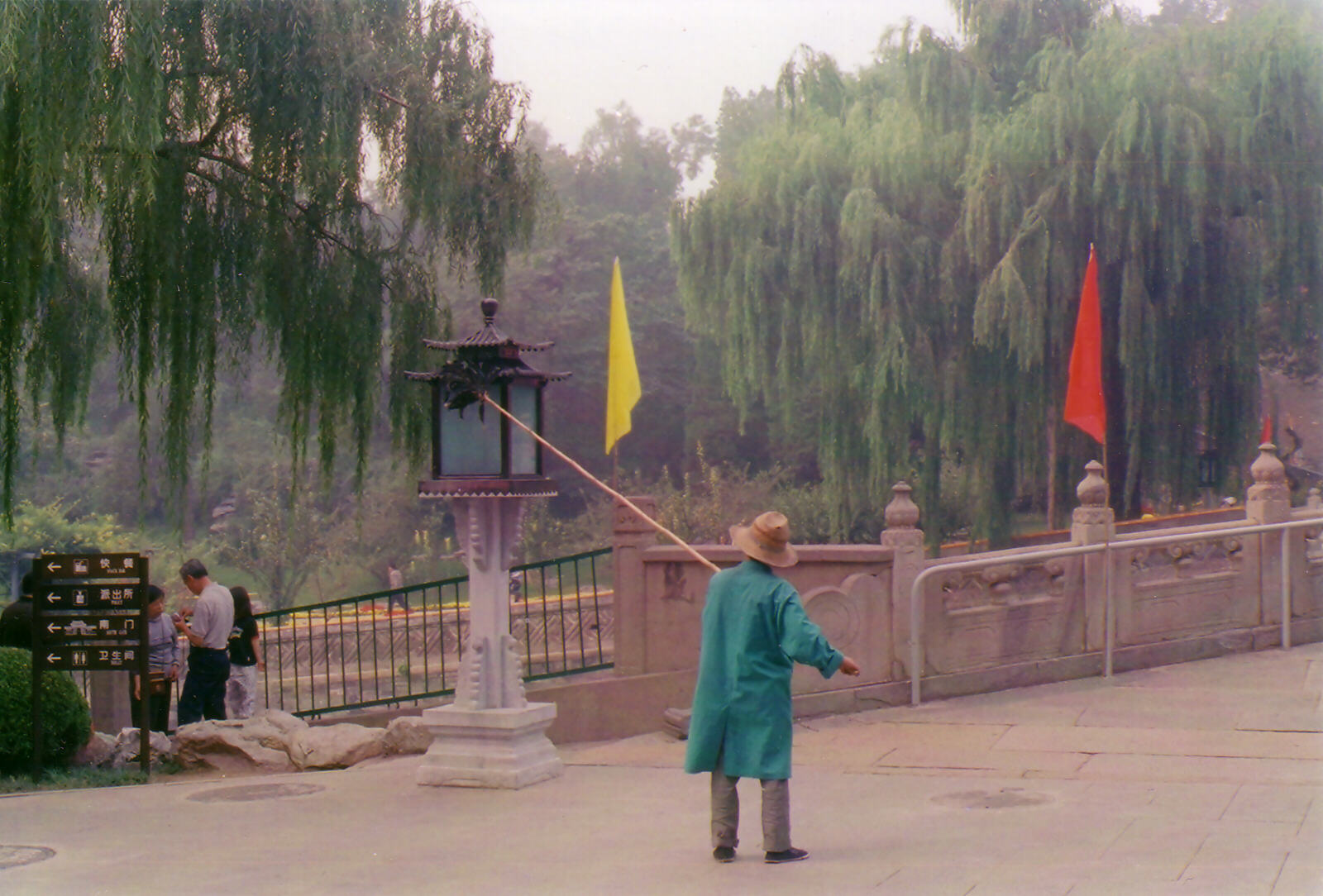
|
We came out of the south gate of Beihai Park and started to walk towards Tiananmen Square. We hoped to walk alongside the moat of the Forbidden City but it was hidden behind buildings all the way, so we got a Tuk-Tuk (motorbike taxi) down to the square. Tiananmen Square is vast, and normally a bare dusty expanse of paving stones, but today the vastness was relieved by the flower displays. We walked to Zhengyang Gate at the south end of the square, one of the old gates in the former city wall. Then we got a taxi back to the Laos Embassy to collect our visas and again we were the only people there. Taxis start at Y10 and the fare to the embassy was about Y20. We walked down Sanlitun Bar Street, obviously the trendy bars where the expat embassy workers and trendy Chinese hang out, and went into Starbucks to get a map of the city with Chinese names on it (the map the China Tourist Office in London hands out only has English names). Having had no luck earlier getting a train ticket to Pingyao, our next destination, we asked at reception in the nearby Comfort Inn if they could arrange it and they very kindly did, even though we were not staying there. We got a number 115 trolleybus back towards our hutong district but unfortunately it stopped short so we walked the last couple of blocks to the hotel, then went on our standard evening walk down the hutong via the peanut stall in the market (each time we get more peanuts for our Y5) to the bar by the bridge for a couple of beers, then to the wonderful Raj Indian where it was warm enough for another superb meal in the rooftop dining area.
Thurs 30th. We set off on 'Tour B', the City tour (there only seem to be two tours on offer at any of the hotels or agencies - Tour 'A' was the Great Wall). After picking up some other travellers, most of whom turned out to be British, we went into the Forbidden City (or Palace Museum, as it is now officially called) by the rear, north entrance. The Forbidden City is indeed a city within a city, a vast collection of impressive pavilions, halls and gates, all built in a similar style. The details are fascinating - the huge brass water pots in each courtyard for fire defence, which were heated by little fires underneath in winter to stop them freezing, and the group of animal figures on the corner of the roof of each building, which indicate how important that building is. This is the roof of the Hall of Preserving Harmony, one of the most important buildings in the Forbidden City. |
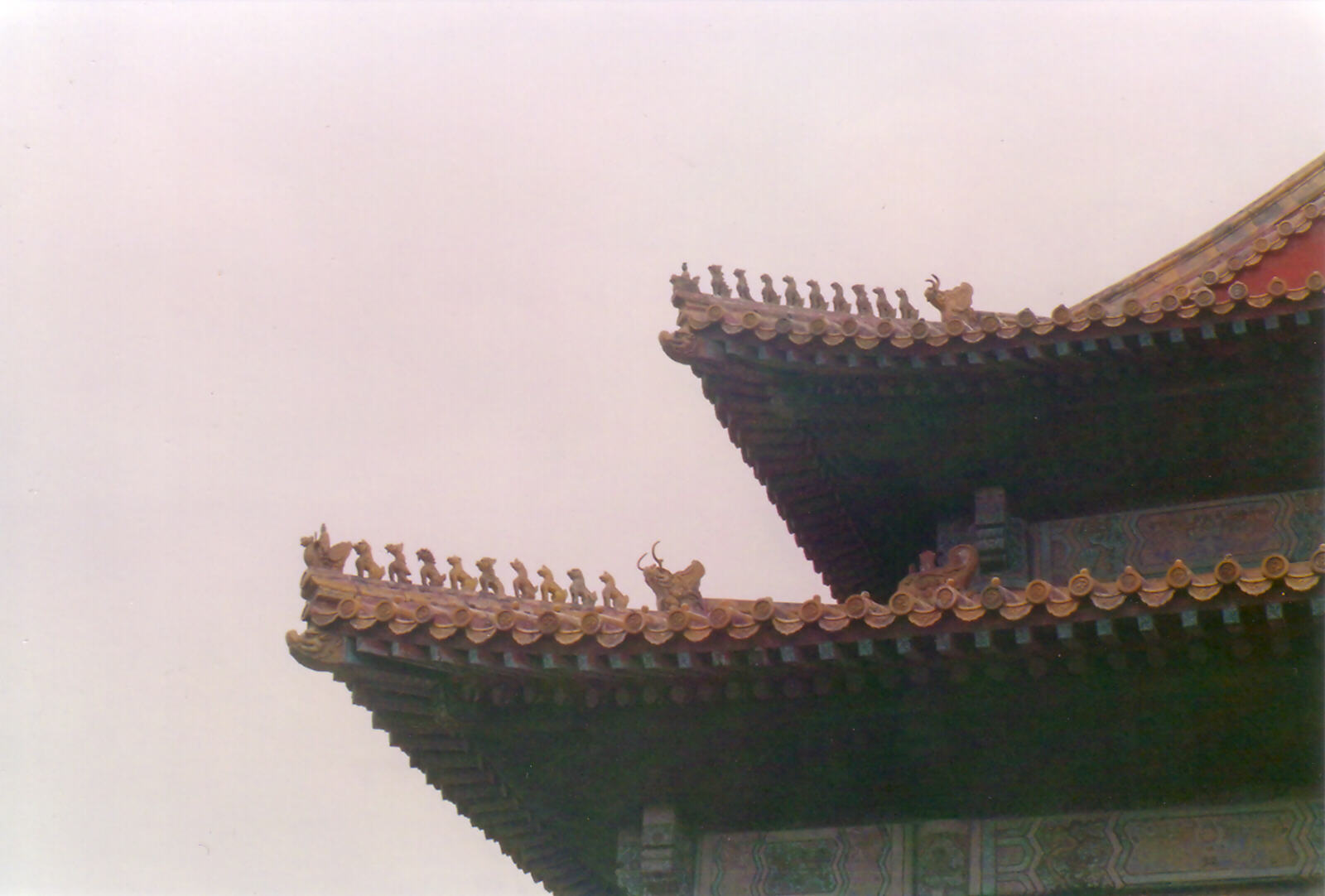
|
It had been drizzling but as we reached the far end of the Forbidden City it started to pour with rain, so we bought yet more cheap kagouls from a nearby vendor who was doing a roaring trade, and returned to the coach. The next stop should have been the Temple of Heaven in Tiantan Park, but we got there to find it closed. This was obviously a surprise to our tour guide, so after a short delay he took us for an early lunch at a nearby restaurant while he considered what to do. After lunch he included an extra item in the itinerary to replace the missing temple and we went to Grand View Garden or the Garden of the Concubines. This garden was constructed to film a TV drama 'A Dream of Red Mansions' and it was built according to the description in the book of the same name, a classic Chinese novel of the 18th century. It was a very pretty park with waterfalls, bridges and pavilions amongst the trees and we trudged round it getting soaked in the rain. After this some of the party decided to give up and go back to their hotels, but all the Brits wanted to soldier on, so we went through a huge detour across the traffic-choked city to drop the wimps off at their hotels, then went on to the Summer Palace. This was also very impressive with lakes, pavilions and pagodas.
After drying off slightly at the hotel, we set off on a 118 trolleybus back to the Comfort Inn to pick up our train tickets, which were ready as promised. We walked back to the Workers' Stadium where we had noticed an Outback Restaurant, where we had very nice Australian steaks with enormous pitchers of ice-cold beer. We felt we should get a few good meals in because we didn't expect too many good meals in the smaller towns (boy, were we wrong). On the way back we stopped to watch the open-air ballroom dancing by the lake.
Fri 1st October. It's surprisingly difficult to find tea in China. They certainly don't do it in the restaurant in our hotel, so breakfast-less we set out on John's walking tour of Beijing. Just to prove how perverse the Beijing climate is, after yesterday's pouring rain today it was beautifully clear and sunny, but with a bitingly cold wind blowing down from Siberia. We went to Jingshan Park, which means Prospect Hill Park, because from the pagoda at the top of the hill in it, there is a fantastic view of the rooftops of the Forbidden City, as well as the rest of the city which was sparkling in the unusually clear and dust-free air. In the park surrounding the hill were beautiful displays of flowers and bonsai trees, and in a building to one side was a tea shop where they showed us the Chinese version of the tea ceremony and we tasted several different kinds of tea, but unfortunately this was followed by the hard sell as they tried in vain to persuade us to buy the ridiculously over-priced teas and teapots. After going back to the hotel for warmer clothes we went to our favourite Raj Indian restaurant again for lunch - we had quite a few meals there because it was an exceptionally good Indian restaurant, and we'll have plenty of chances to eat Chinese food on the rest of the trip. Then we set off through the interesting hutongs and back streets in the northern part of the city. |
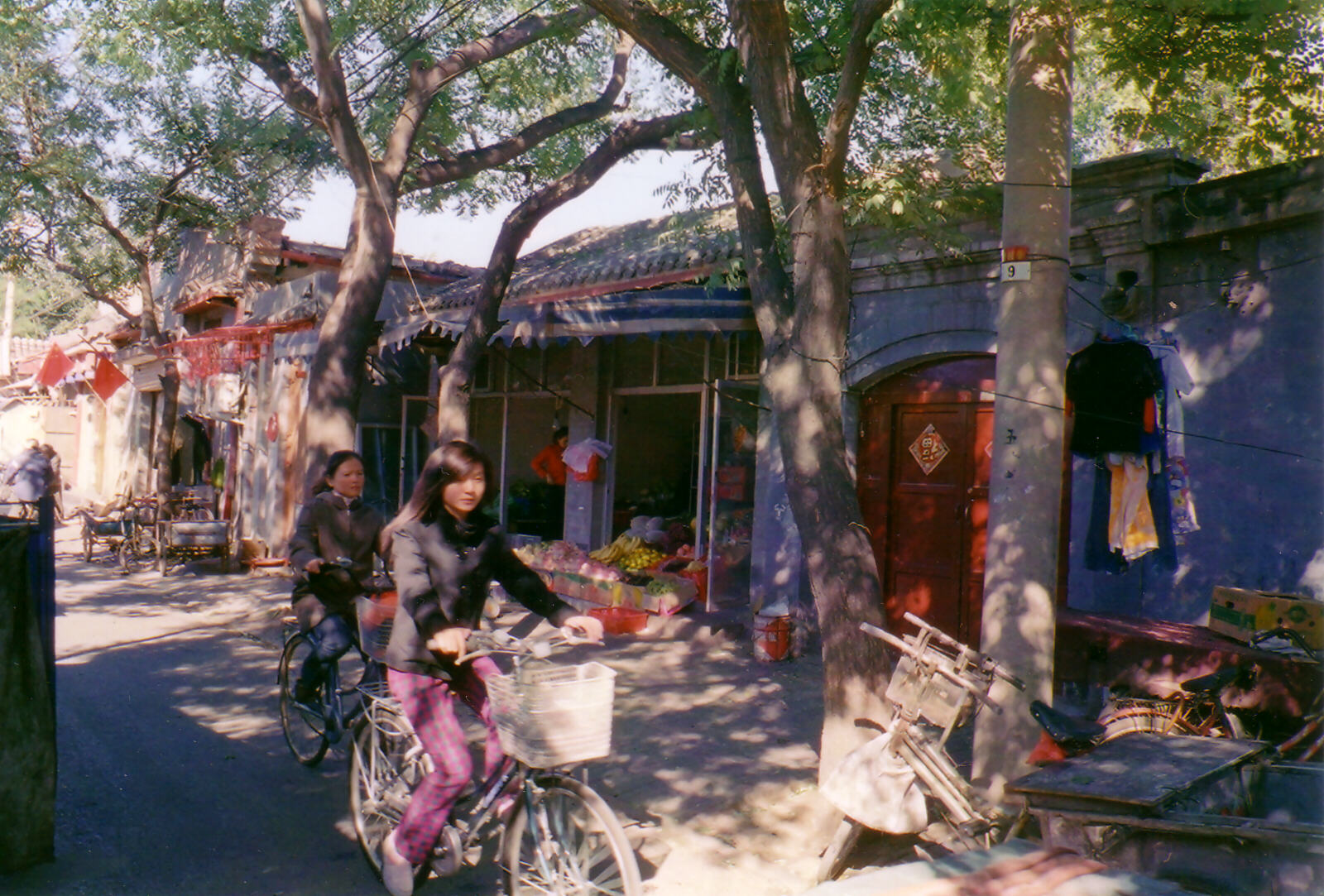
|
We carried on walking until we reached the Lama Temple. This is a wonderfully colourful Buddhist temple complex covering a large area with many different halls housing Buddha statues that get gradually bigger until you reach the final hall with a huge standing Buddha inside, who looks much taller than the building appears to be from the outside! As well as being a major tourist attraction we were pleased to see that it is also a working temple with a surprising number of young people praying to the Buddhas. The Lama Temple was fascinating and we lingered there for some time until we realised that we were running late, and just got to the Confucius Temple down the road opposite before it closed for the evening. The Confucius Temple seemed much quieter than the Lama Temple and a bit more dusty and neglected, but still very interesting. |
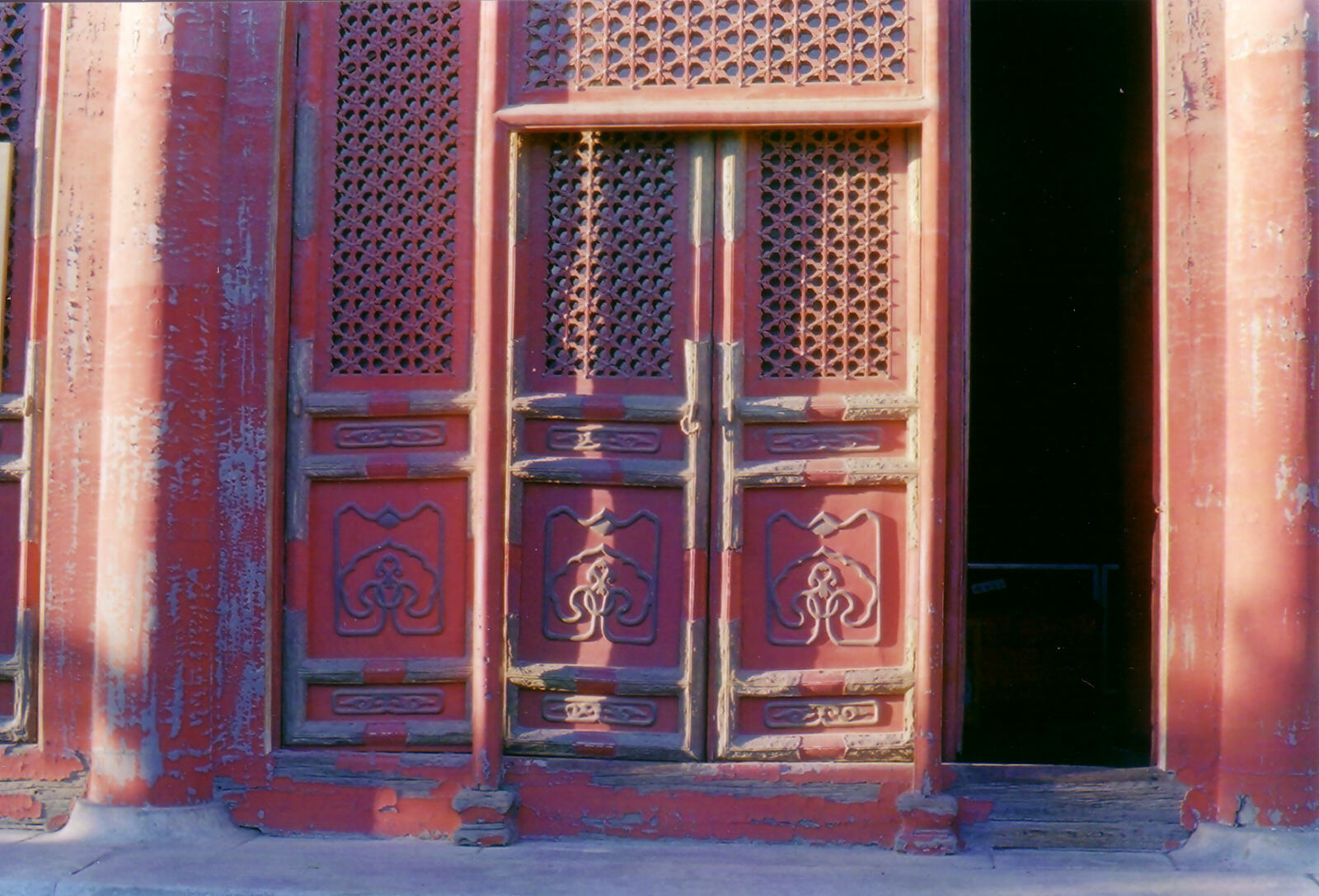
|
It was now getting dark, so we decided to do a 'dry run' to the station where we would get the train tomorrow. Beijing West Station is at the diametrically opposite corner of the city, so rather than sit in a traffic jam paying a taxi driver for hours, we got the metro round to the nearest station then had a short taxi ride from there. Beijing West is huge and crowded (yet it is not even the 'central' station which is further to the east). We found the soft-seat waiting area (easy to find because it was signposted in English) which was an oasis of calm in the chaos of the rest of the station, and we also queued up at several different ticket windows to try to buy our onward ticket from Pingyao to Xian, but this turned out to be impossible. We were even captured by some touts who thought we wanted somewhere to sleep, and they showed us some little box-bedrooms that you can rent, just off the main station concourse. The final challenge was finding the taxi rank to get away again, which was several levels down in the lower recesses of the building. We got a taxi round the ring road to the Shisha Hai lakes and our favourite bar by the bridge, where we finished the day by having several beers and chatting to the bar owner in broken English.
Sat 2nd Oct. After packing up our belongings and leaving them with the hotel, we set off on another walkabout. We walked down to the lake to photograph some old houses, then on to the Drum tower and the Bell Tower, which used to sound the hours over old Beijing. After climbing some very steep steps we got to the drum chamber which was full of dozens of big drums, while outside there were superb views of the city and the nearby Bell Tower. |
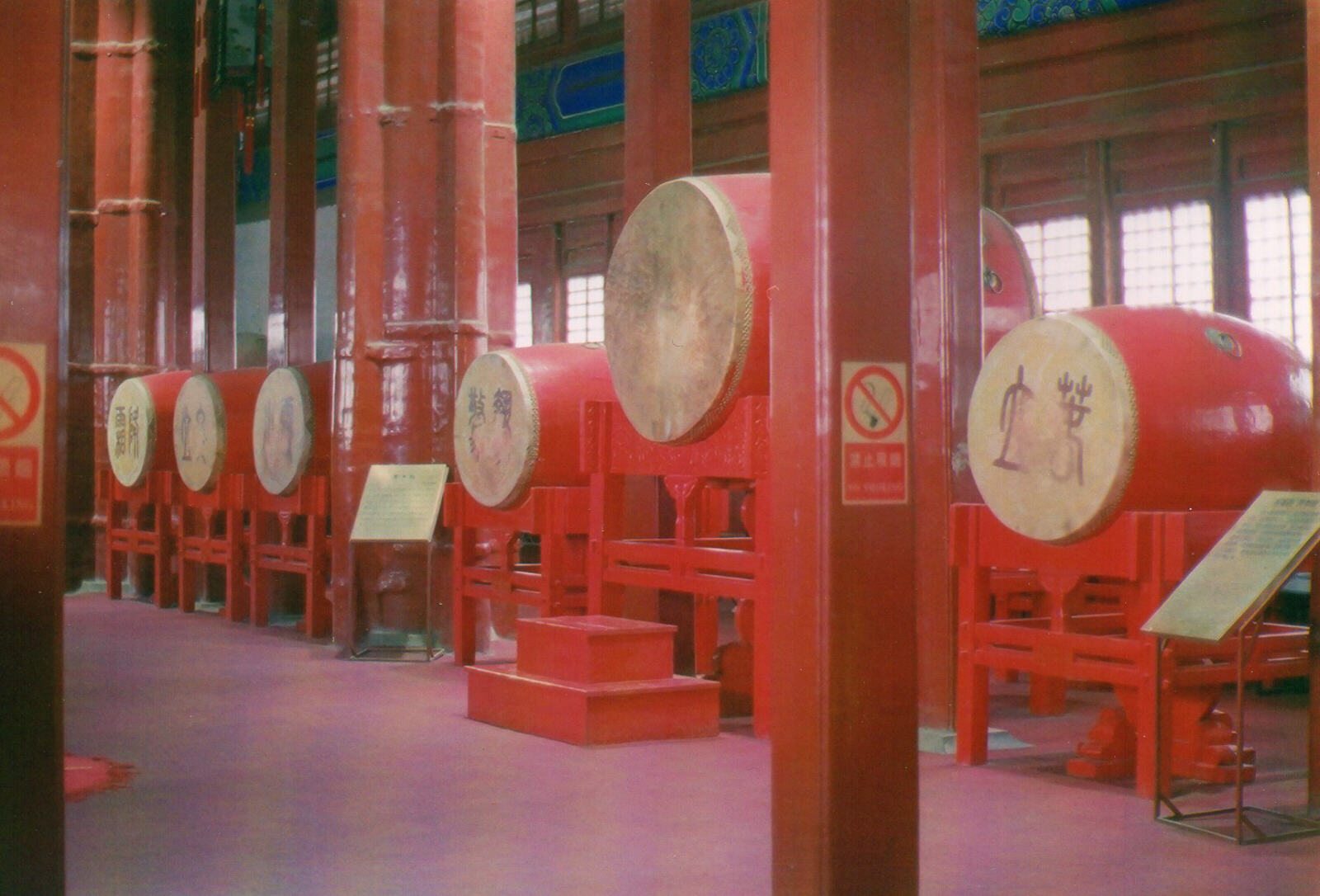
|
Up some equally steep steps, the Bell Tower had one huge bell and good views of the Drum Tower. We met Marty, an American who lived in Beijing, and she recommended nice places to stay in our destinations after Beijing. We went back to the Drum Tower in time for the regular drumming show, then got a taxi right across town to the Temple of Heaven, another of the must-see sights, which is lovely with a blue tiled roof and golden pinnacle glinting in the sun. It was so nice we were late leaving and even later due to the awful traffic jam, so we had to rush our last meal at the Indian restaurant, where the owner kindly arranged for his car and driver to take us to the railway station. The driver was certainly fast, but he went a very long way round so that we arrived at Beijing West station in a big rush, just in time to catch our 7:45 pm train. |
Pingyao, Shanxi province
|
Sun 3rd to Tues 5th Oct. The sleeper train (446 Yuan each) was very cosy and it was pleasant dozing as we trundled along, falling behind schedule until we arrived at Pingyao at 8:30 am, 1½ hours late. By luck, we managed to get taken in a rickshaw from the station to the hotel which had been recommended to us - the De Yu Yuan, in a lovely old traditional wooden house with the rooms arranged round a central courtyard, in West Street in the old town. We got a traditional room, where the huge bed was actually a thin mattress spread on a brick base, with a compartment underneath where they put hot bricks to keep it warm in the winter! And all this for only Y150 (just over £10) a night. But not once in the whole of China did we have a soft bed! |

|
We set out on a walking tour of the old walled city of Pingyao which was wonderful. It used to be such a poor town that it somehow got forgotten in China's modernisation, so instead of the usual smoky factories and grey apartment blocks, there is street after street of classic Ming-era houses with wonderful wooden beams and courtyards, decorated with colourful Chinese lanterns. There are four gates into the city linked by an intact six-km city wall complete with watch towers. It was absolutely packed with Chinese tourists and the hustle and bustle, the old houses and the impressive gates and wall made it all seem quite medieval. Of course, most of the stuff for sale on the stalls and in the shops was the normal tourist fodder, but the atmosphere was wonderful. Expert caligraphy was available on one of the street stalls. |
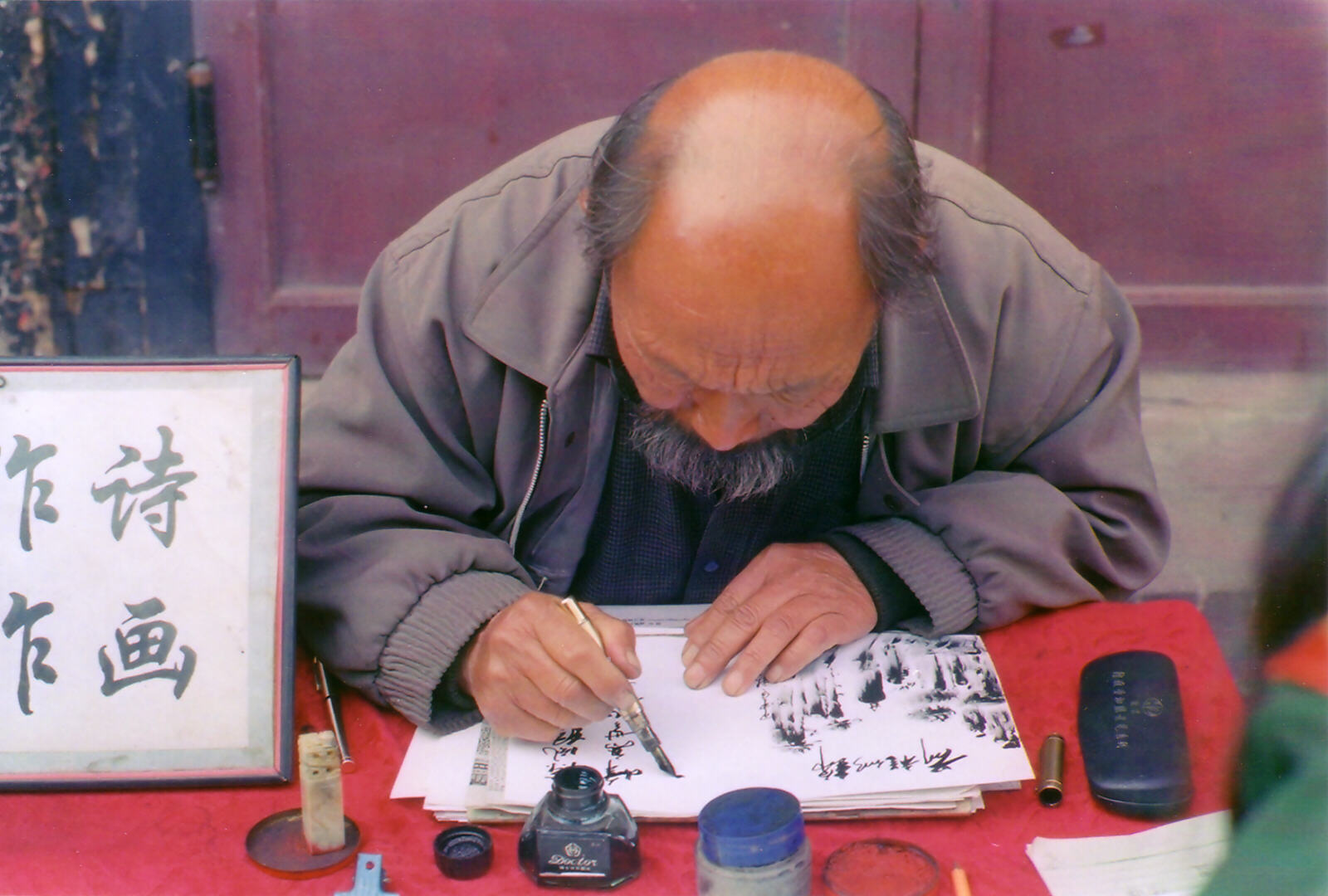
|
A card game in a side street in Pingyao. |
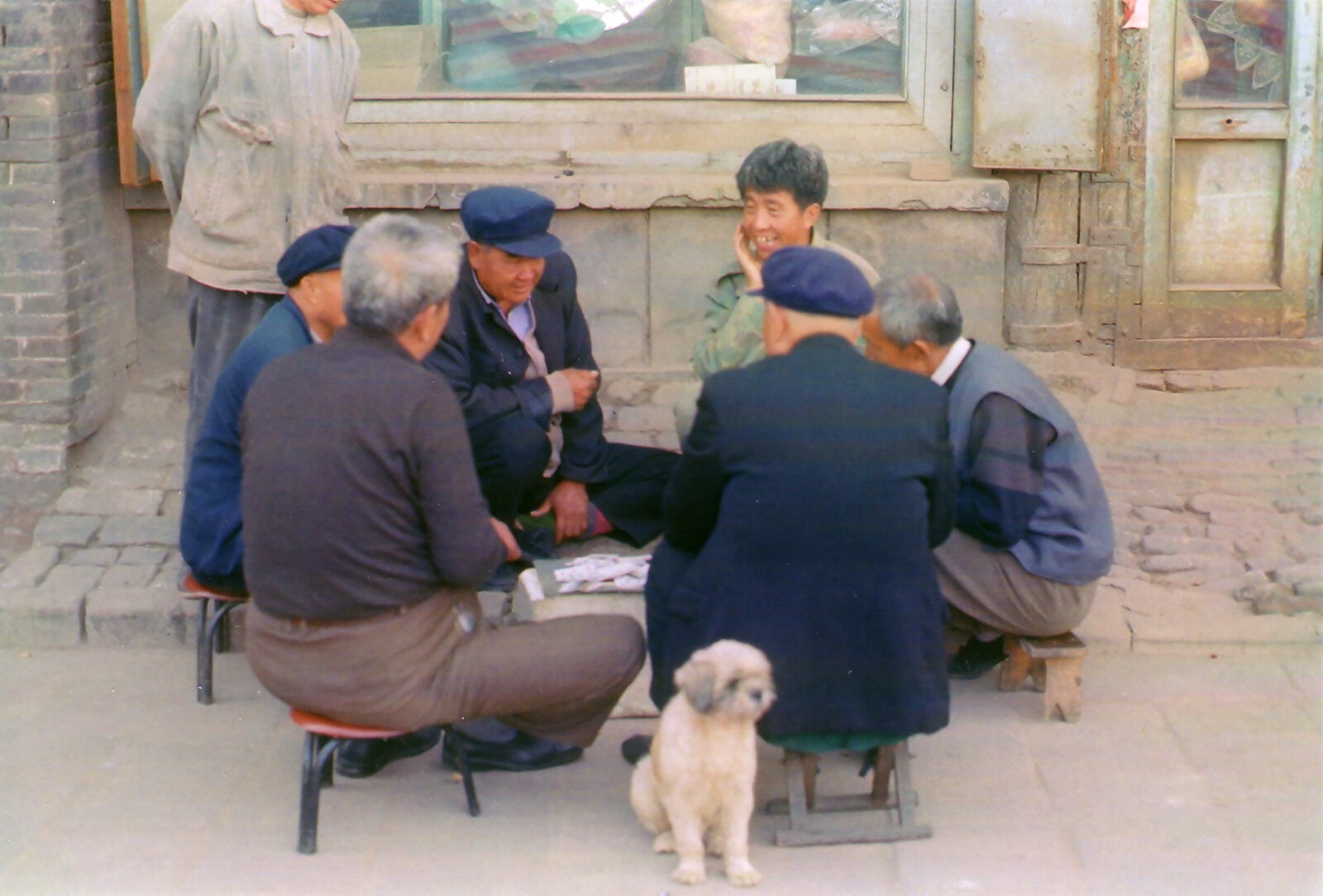
|
We bought the 'Ancient City' tourist ticket for Y120, which is valid for three days and gets you into 20 of the historical sites. Over the three days we visited merchants' houses, former banks, temples of various sorts and the City Tower, which was an extra Y5 (everything else was on our Ancient City ticket). This is the City Tower in South Street. |
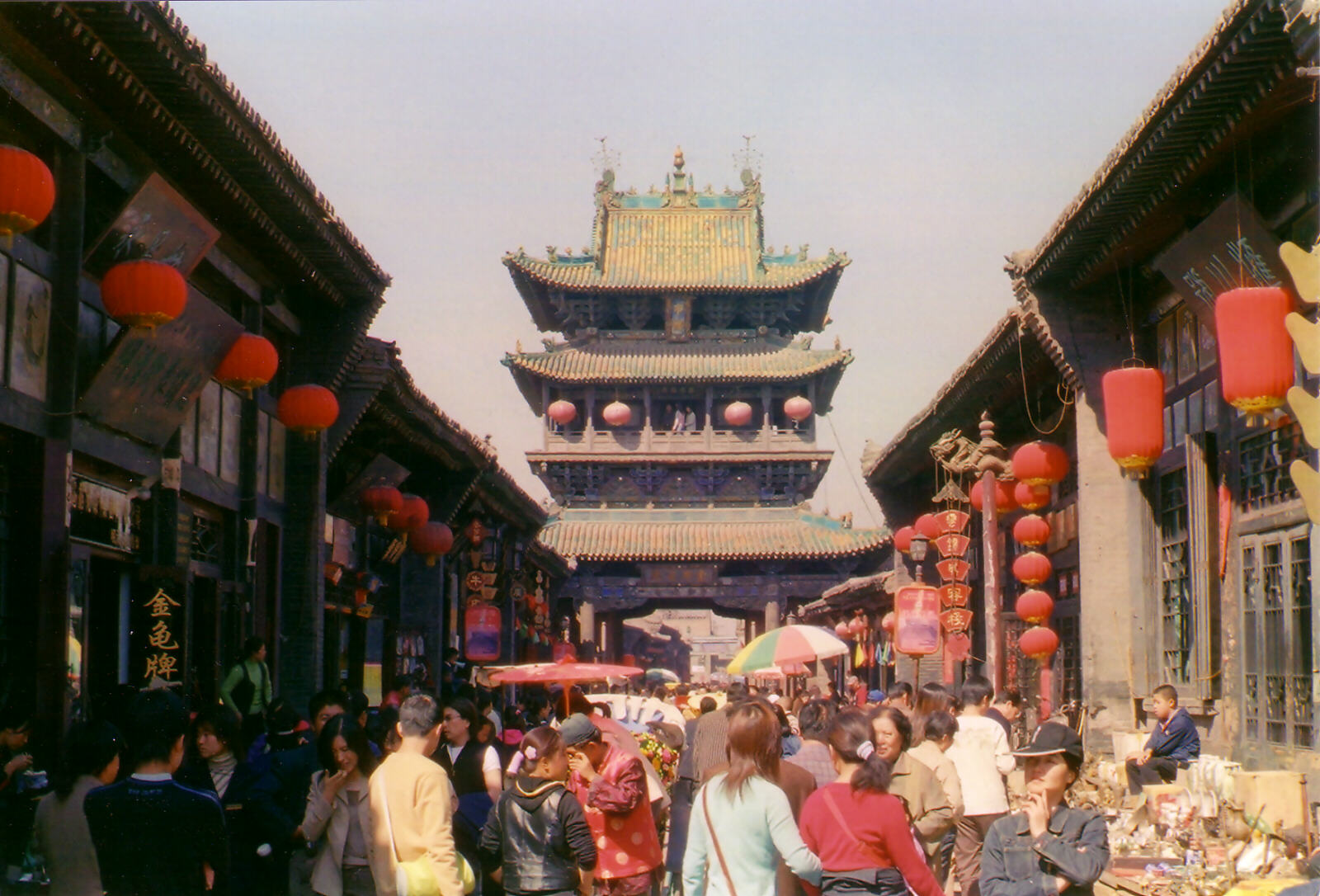
|
The style of many of the traditional buildings is very similar, with the main halls on a south-north axis and the minor buildings around courtyards in between. We managed to see about 18 of the 20 sights before they all started to blur together! In the Confucius Temple people were lighting giant incense sticks outside the Hall of Great Accomplishments. |
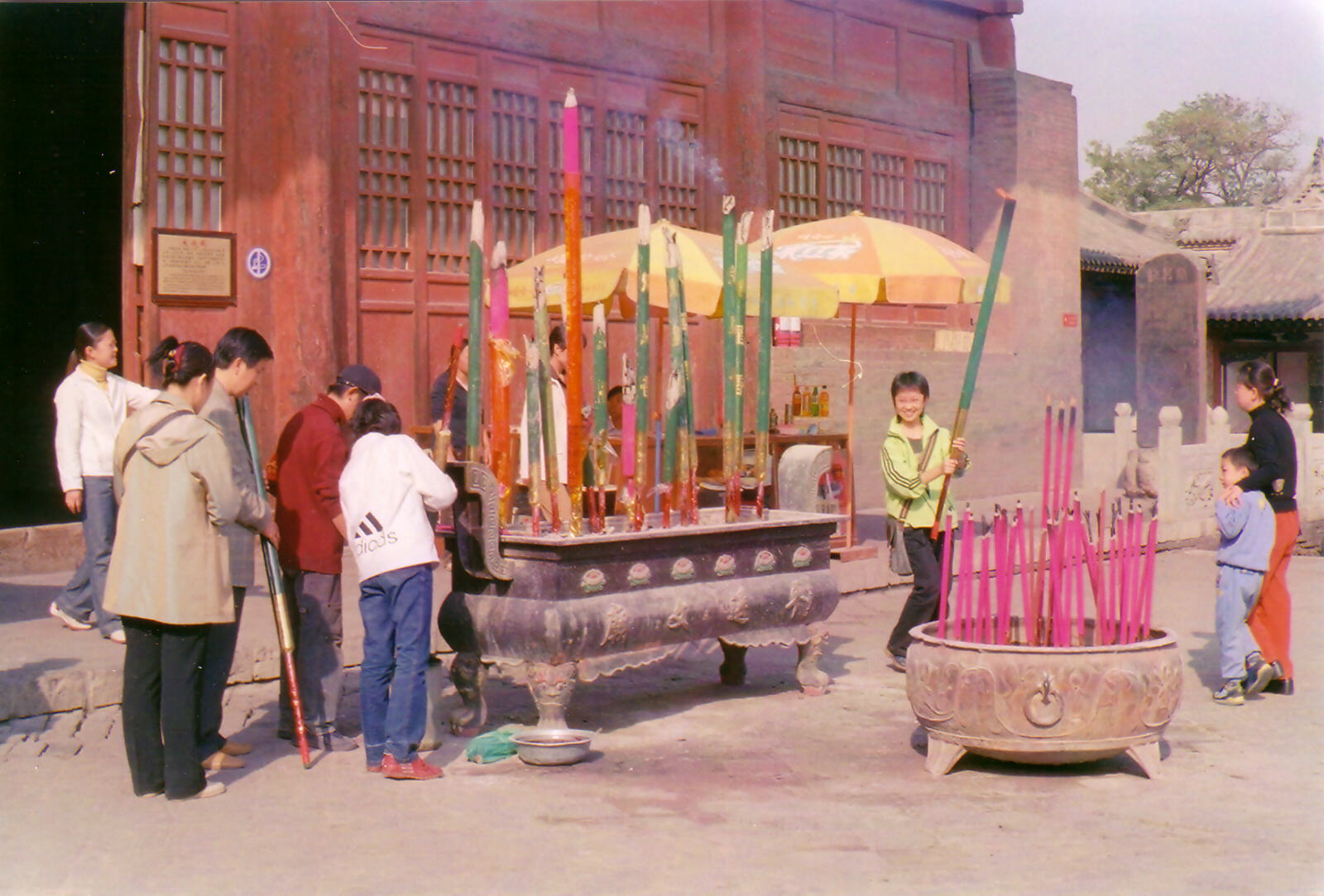
|
The second day, after a breakfast of omelette and banana pancakes in our hotel, sitting by the front window watching everybody in the street watching us, we set off for a walk round the city wall. By lucky chance we picked the most interesting section of the wall to start - we entered by the East Gate and walked round the southern wall to the West Gate. All the way along the wall were watch towers, while down in the city below were a constant succession of interesting old houses with tiled roofed buildings surrounding courtyards with piles of corn-on-the-cob, red peppers and the occasional chicken and goat. It was a fascinating walk, and very quiet because the majority of the tourists seem to go to the West and North Gates. We continued round past the West Gate to the North Gate, but this section was much less picturesque, with modern flat-roofed prefab-style houses. After completing three-quarters of the circuit, about three miles, with constant stops and backtracks for photographs, we were exhausted so we returned to the hotel for a beer and Chinese lunch. This is the watch tower in the northwest corner of the city wall. |
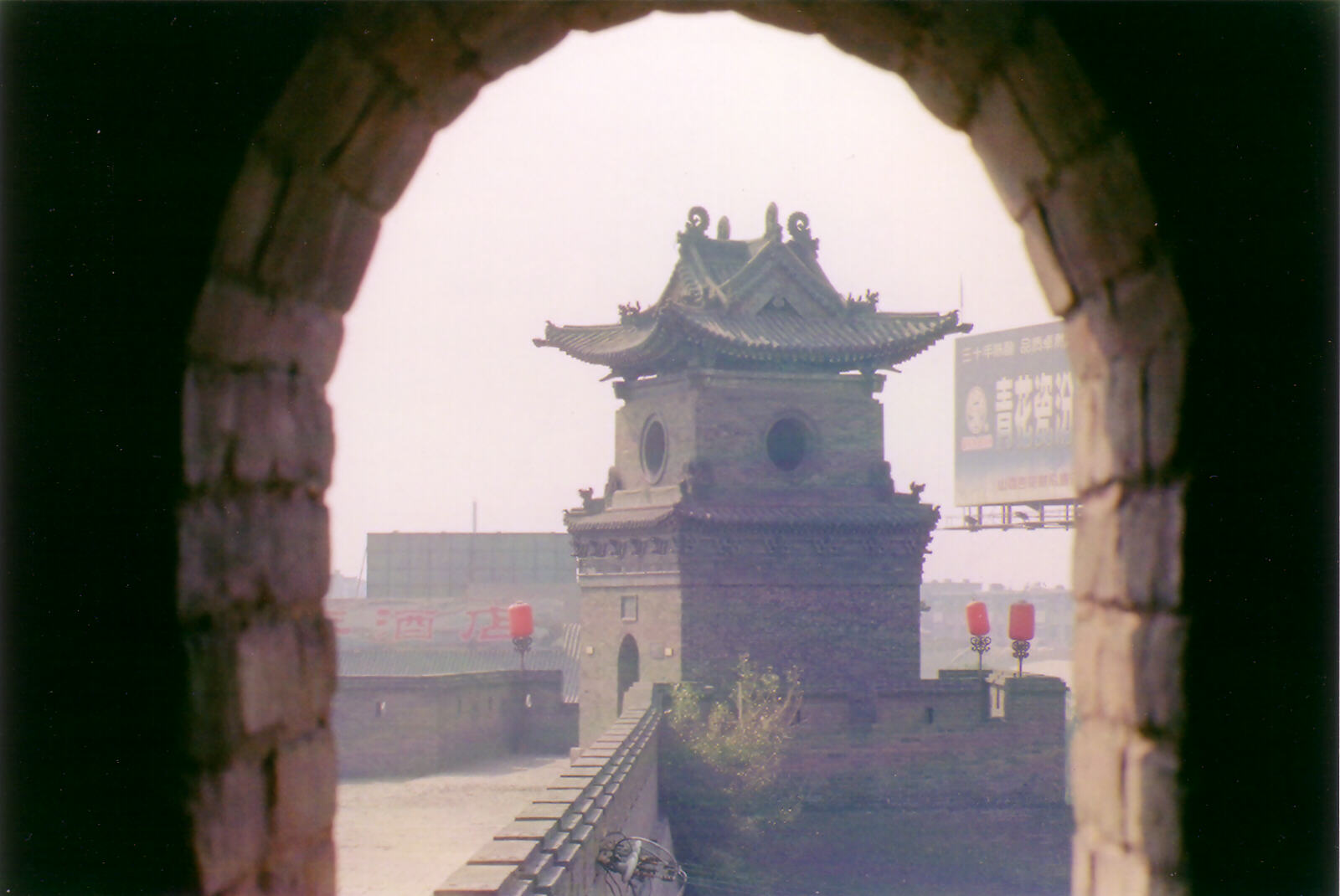
|
We walked around the back streets and found typical farmyards.
|
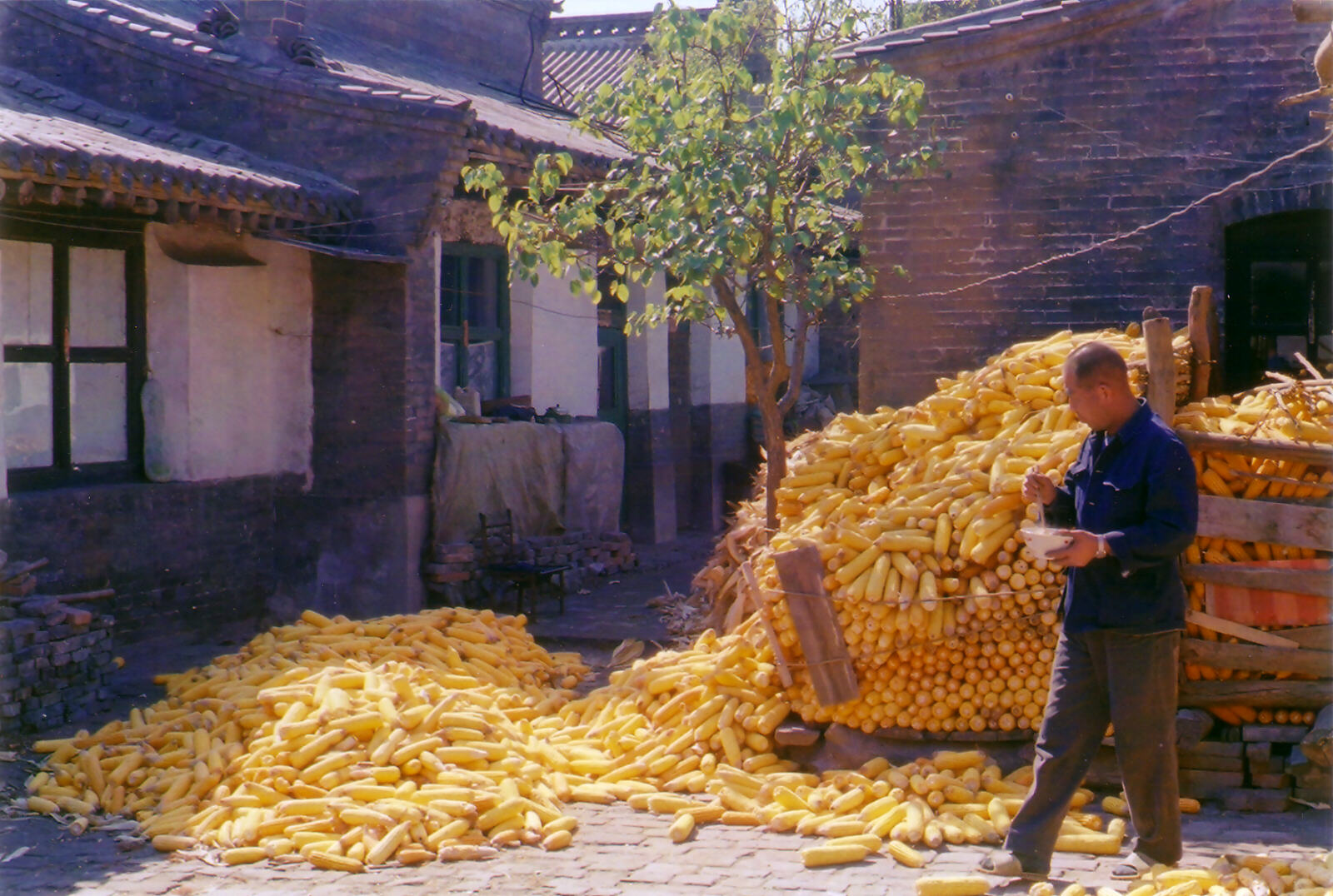
|
That evening we found a restaurant with a first-floor balcony overlooking the street (which was unusual as most of the houses are single-storey). We sat there watching the life in the street below, drinking beer and eating some very nice sweet-spicy chilli peanuts that we had bought in a little grocers shop nearby. For dinner we had a corn on the cob from a street vendor, then because it was too early to go to bed and she had sore feet, Sheila decided to have a pedicure and a massage to finish the day. This turned out to be more grievous bodily harm than the gentle massage she was hoping for, delivered by a strapping young Chinese man with hands of iron, and it lasted for an hour and had her biting her knuckles in pain!
Another evening we returned to our own hotel for dinner because it had one of the best menus and was one of the most attractive buildings that we'd seen. All the guest houses are also restaurants (or the restaurants are also guest-houses) and all the food in the town is Chinese, there is not a McDonalds or KFC in sight, thank goodness. At the hotel we had another nice meal and met Marty and Carol who had recommended the hotel when we met them back at the Drum Tower in Beijing, and who had just arrived in Pingyao. Then the hotel owner very kindly gave us a lift to the station and made sure we got into the right carriage of the soft sleeper train to Xian (337Y each). |
Xian, Shaaxi province
|
Wed 6th to Thurs 7th Oct. We arrived in Xian about 8am and went to the Golden Bridge travel agency in one of the big hotels because the guide book said they could get cheap deals on some nice hotels. In the end they couldn't, but we booked the Terracotta Warriors tour with them for 9 o'clock, and went down the road and negotiated a good price (Y278) at the nearby Xian Melody Hotel. There wasn't time to move our luggage from the travel agent's office to the hotel because the tour was due to start, so we set off with just us, Brian and Nancy the guide. First we went to the Banpo Neolithic village, but the actual reconstructed village was closed so we looked round the museum pretty quickly then went on to the tomb of Qin Shihuang, the first Chin dynasty emperor, and the chap whose tomb the Terracotta Warriors are guarding. The tomb is essentially a big hill, so we walked up to the top and down again then went for lunch. Outside, Sheila was excited to find a place selling Magnum ice creams and even though they were very stale, she enjoyed it! After lunch we went to see the warriors themselves, in their massive exhibition halls. It was impressive to think that all this was once a field, and many metres deep underneath it the terracotta warriors had been standing guard for over 2,000 years, waiting to see the light of day. |
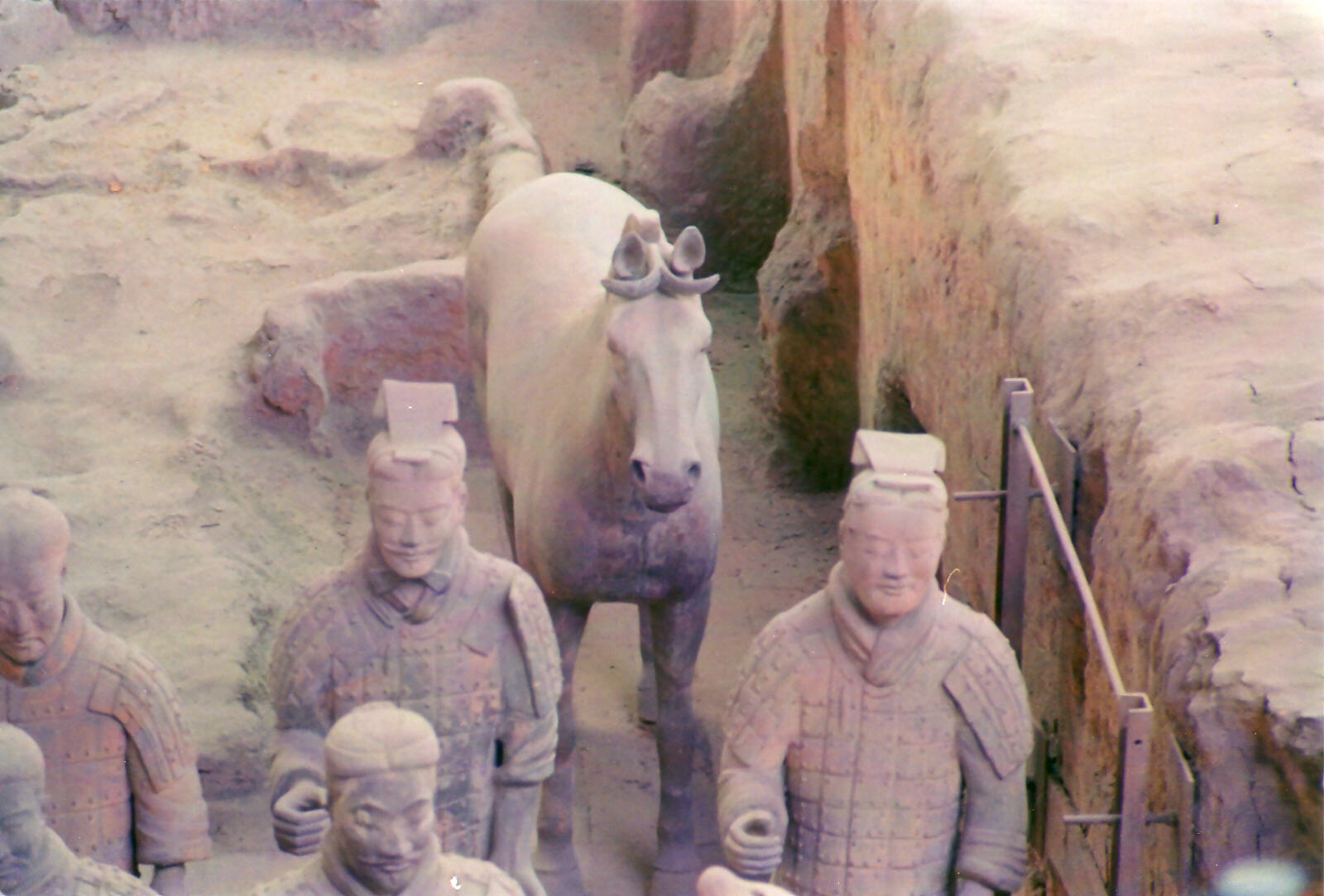
|
Back in Xian that evening, we went walking around looking for a bar or the restaurant marked in the guide book, but couldn't find either, so we ended up in a local restaurant with no English menu, but with some help from another diner who spoke English we had a delicious Chinese meal.
The next morning we went on John's walking tour of the Islamic Quarter of Xian, north and west of the Drum Tower, which was wonderful - it was basically a huge street market with noodle-makers, all sorts of food being cooked up at street stalls, a fur pelt stall, barrows with vegetables and meat, sheep's heads, and all sorts of animal innards for sale - not for the faint hearted! This woman is weighing out pomegranates. |
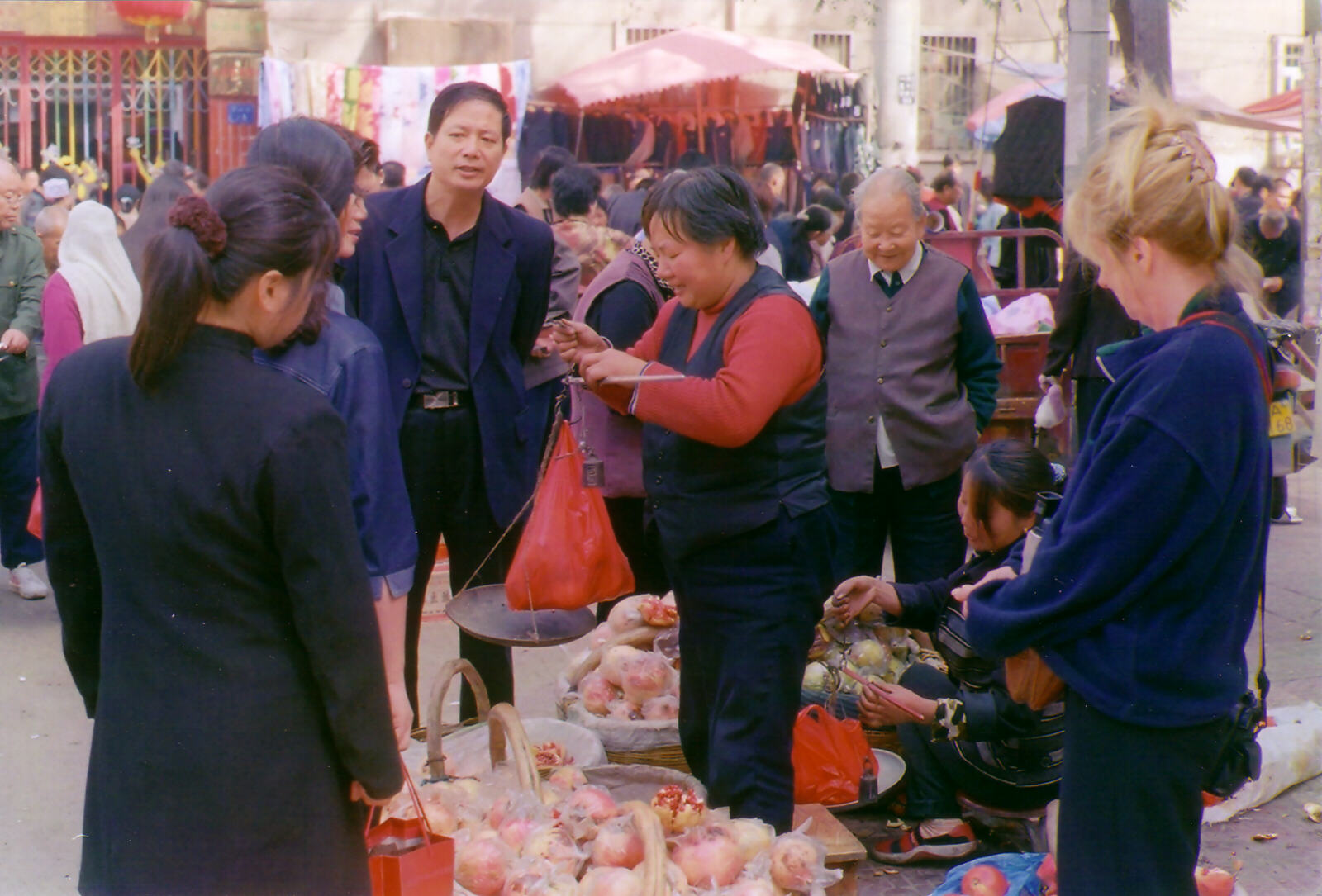
|
Reluctantly we had to leave, walking back along the tacky tourist market by the great mosque to the hotel, and got a taxi to the railway station for the train to Chengdu. It was nice to be on a daytime train for the first time, and we sat in the restaurant car having beer and peanuts and watching the Chinese countryside go by, until they threw us out because they needed to clean it. We sat in our four-berth compartment for a while with a nice Chinese man and his sulky, spoilt daughter until they got out and we had the place to ourselves for a good night's sleep. |
Chengdu, Sichuan province
|
Fri 8th Oct. We arrived at Chengdu at 5:30 am and bleary-eyed got a taxi to the Traffic Hotel (240 Yuan a night) which sounded good in Lonely Planet and turned out to be very good indeed, with very helpful staff who all spoke good English. No sooner had we checked in than we booked ourselves on a trip to the Panda Breeding Centre just outside the town, and after a quick breakfast of toast and tea we were on our way at 7:30. The morning is the best time to go because it is feeding time and the pandas are all lying on their backs or sitting up, munching away at bamboo leaves, then they sleep for the rest of the day. |
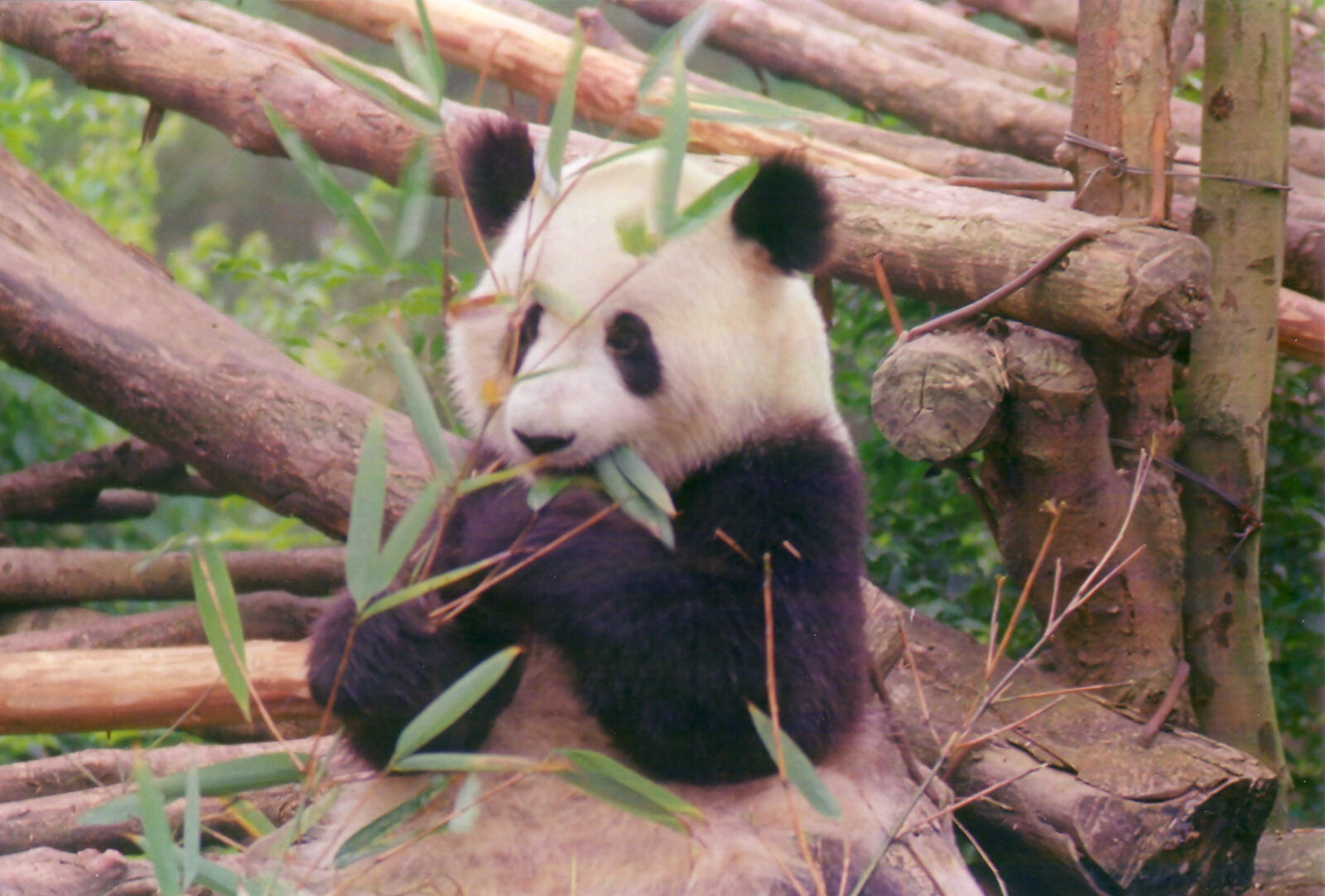
|
In one enclosure there were two playful adolescents playing slow-motion rough-and-tumble and pushing each other out of the branches to the delight of the tourists. |
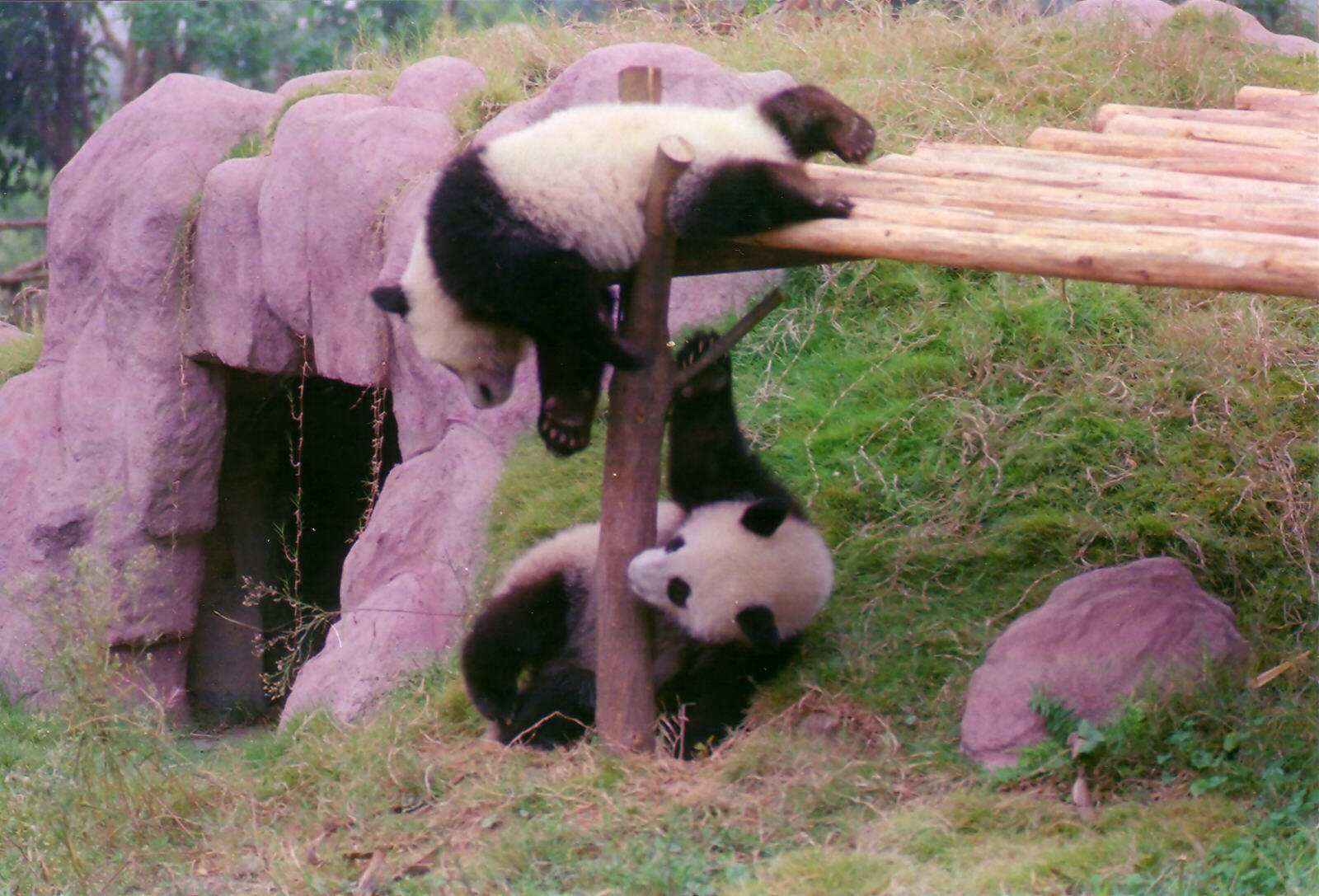
|
Baby pandas eat fruit until they get older when they are able to digest the bamboo leaves. The Panda Centre is a large bamboo-filled park which is more pleasant than the zoos and the pandas all seemed quite cheerful. For $40 you could have your photo taken with a panda sitting on your lap! As we drove back to town, our two fellow-passengers who were from Israel told us there was a nice Pizzeria called High-Fly Pizza just down the road from the hotel and we were suddenly overwhelmed with a desire for pizza! So for lunch we had excellent pepperoni pizzas with Yunnan red wine and a beautifully-presented tomato and onion salad.
After this large lunch Sheila had to have a nap, so I went on the number 82 bus to Dr. Fu's Thatched Hut on the western outskirts of Chengdu. Dr. Fu was a very famous Chinese poet and philosopher and he lived in a thatched hut here a thousand years ago. The hut is long gone but there is a very nice garden with rivers, waterfalls and halls with examples of Dr. Fu's poetry. The number 82 bus came back a rather different way due to the one-way streets, which worried me briefly, but having eventually arrived at the hotel we crossed the river and sat in a tea house having tea and beer while around us old chaps played cards and dominoes and the ladies knitted and sewed. I had a pot of lemon black (Lipton's) tea, which came with a 'never-ending' thermos flask of boiling water. We then walked down the riverside to the Indian restaurant next door to the Pizza place and had a nice, but not great, Indian meal. It was all happening out on the street as we walked back - men on lifting lorries were erecting great strings of flags across the road by attaching them to the lamp-posts (without bothering to stop the traffic below, of course). We walked through English Corner, where a crowd had gathered to practice talking English to each other, and finally we passed a slow-motion aerobics group practising to music in the park by the river. |
The Giant Buddha of Leshan
|
Sat 9th Oct. Yesterday we enquired at the travel agency in the hotel about trips to Leshan to see the giant Buddha, but she said we'd be better off getting the ordinary bus from the bus station next to the hotel, so about 9 o'clock we walked round there and bought two tickets with allocated seat numbers at Y37 each for the two-hour journey, and soon we were rolling down the motorway in the very comfortable bus, watching Tom and Jerry cartoons dubbed into Chinese on the in-bus TV.
However, when we arrived in Leshan my carefully calculated sightseeing plan turned into a bit of a muddle. I wanted to get a taxi from the bus station to the boat dock, then a ferry across the river past the giant Buddha, then walk back past temples and the Buddha itself, avoiding the new 'Oriental Buddha Park' which is a sort of Buddha theme park that has been created nearby to cash in on the Buddha craze. In fact, as we got off the bus from Chengdu we were shepherded straight onto a local bus which everybody said was going to the 'big Buddha'. I didn't know that the bus station had moved and we were actually only a couple of minutes' walk from the ferries, so we got onto the local bus and were whisked out of town, over a bridge and to an entrance gate which we found, once we had paid Y30 each and were inside, was the new Oriental Buddha Park. We climbed the steep steps to the centre, past the assortment of Buddhas old and new that have been brought here from all over Asia, down the other side of the hill and through another gate where we paid another Y70 each to actually get into the Great Buddha park. After climbing up another hill we spotted the top of his head and finally arrived at the world's largest Buddha, sitting serenely staring at the river, oblivious to the tourists (mostly Chinese) photographing him from all angles. |
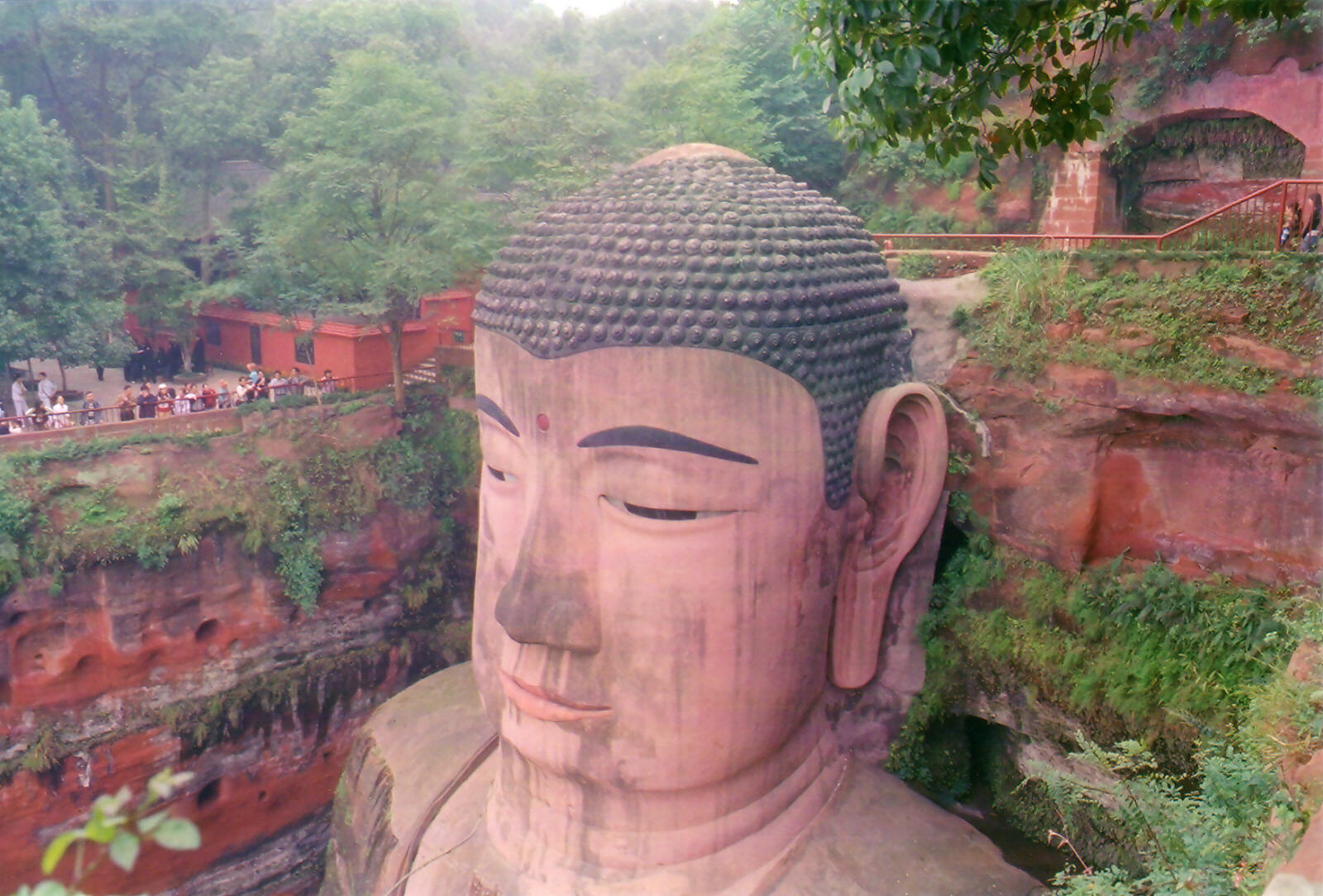
|
We climbed down the tricky, steep steps to foot level and took more photos as he towered above us. We were lucky that we had not come the week before during the national holiday, because then the queues to climb down the steps were hours long and most people abandoned the attempt. This is on the river near the Giant Buddha Park. |
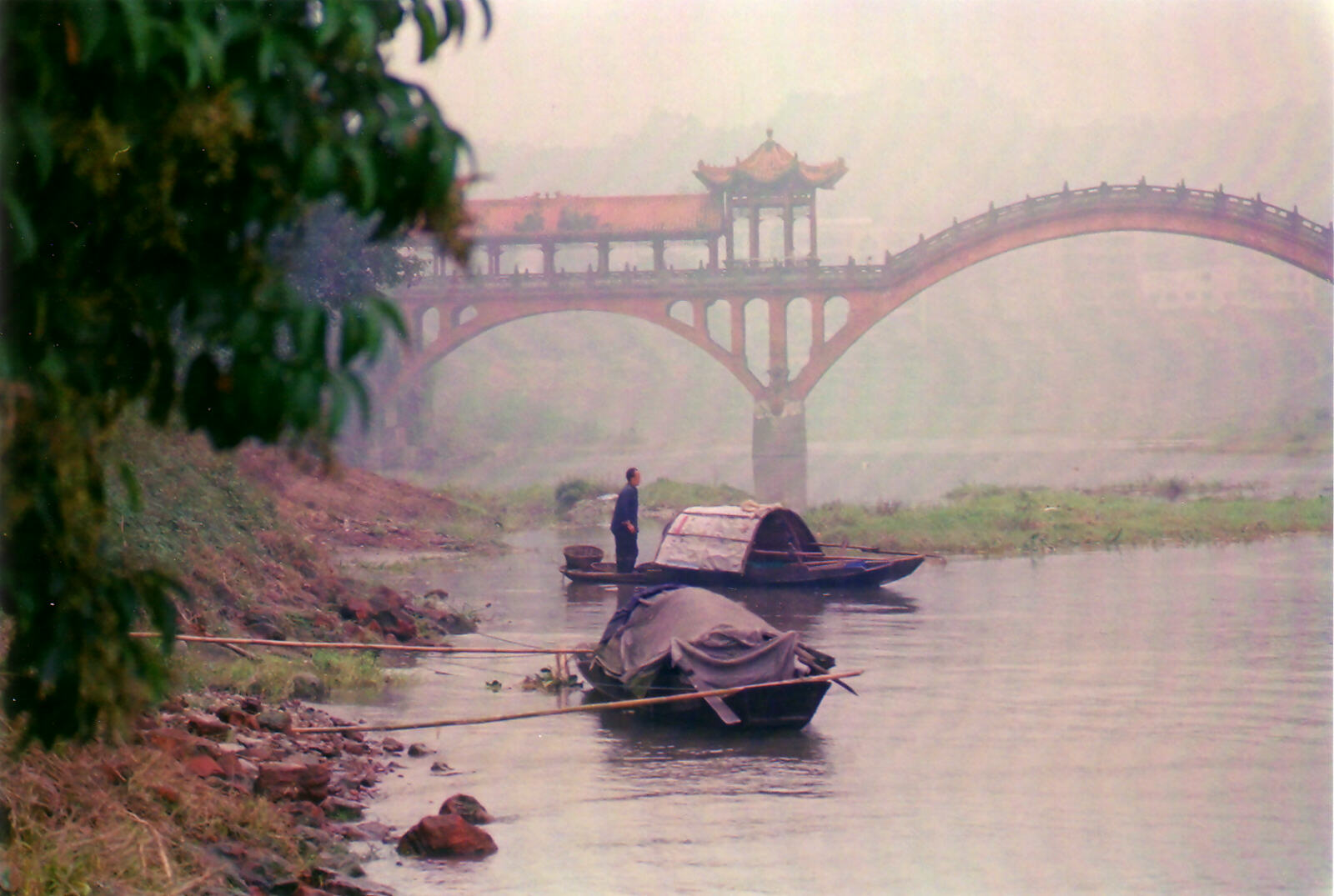
|
Then we set out to try to find some of the surrounding temples. After climbing up and down more steep hills we found a boat pier, so we booked an expensive Y50 speedboat tour up the river past the Buddha and back to Leshan, instead of the much cheaper ferry. The speedboat tour was fun because the driver manoeuvred the boat up to the Buddha then drifted back past him several times while we all took photos, then sped off to Leshan boat dock near the bus station. After dozing through the bus ride back to Chengdu we went to our riverside teashop to rehydrate with a 'bottomless' lemon black tea, then went back to Highfly Pizza for another wonderful pizza with local red wine.
We reclaimed our bags from the hotel and set off for the railway station, arriving in good time for once and had a rest in the comfortable soft-seat waiting lounge, then found our soft sleeper carriage for the 14-hour overnight train to Panzhihua (Y414 each). We had the two upper bunks this time which is fine for an overnight train, because you get lots of luggage space above the corridor. Our companions in the lower bunks were two Chinese ladies who did not want the loud music on or to sit up talking till all hours, so we soon settled down for a comfortable night. |
Lijiang, Yunnan province
|
Sun 10th Oct. Travelling to Lijiang. We both slept really well and awoke refreshed. We arrived at Panzhihua railway station and began a very interesting bus ride to Lijiang. First we got a minibus for Y3 to the 'bus station', which actually meant that we drove for a while then stopped by the side of the road and in a few minutes the bus came along and we got the last two seats, with the luggage piled with everybody else's in the aisle. We then set off on the eight-hour ride to Lijiang through fantastic scenery, across mountains and rivers in valleys, past farming communities ploughing with oxen and all the time going further up into the mountains of Yunnan province. It was hard work, bumping along the dusty road packed in with the local people and their luggage, but it was fun until it began to go dark and we felt tired. We arrived at Lijiang and had the usual bust-up with a taxi driver, this time because we couldn't understand that he was trying to tell us that the old city is closed to cars so he couldn't take us where we wanted to go, and we realised afterwards that he was only trying to be helpful and actually asking for less money than we paid him! We ended up at the Tian Shun Xing Inn in a traditional wooden house with the rooms arranged around the courtyard, which was very nice for Y80 a night. After a quick beer at a first-floor bar overlooking the old market square and a quick Chinese meal at the Tower Café also overlooking the square, we went to bed exhausted.
Mon 11th to Weds 13th Oct. In Lijiang. Lijiang is absolutely lovely. The old town has cobbled streets alongside sparkling rivers, across which are lots of bridges and picturesque wooden houses, and it was all very pretty in the warm sunshine. |
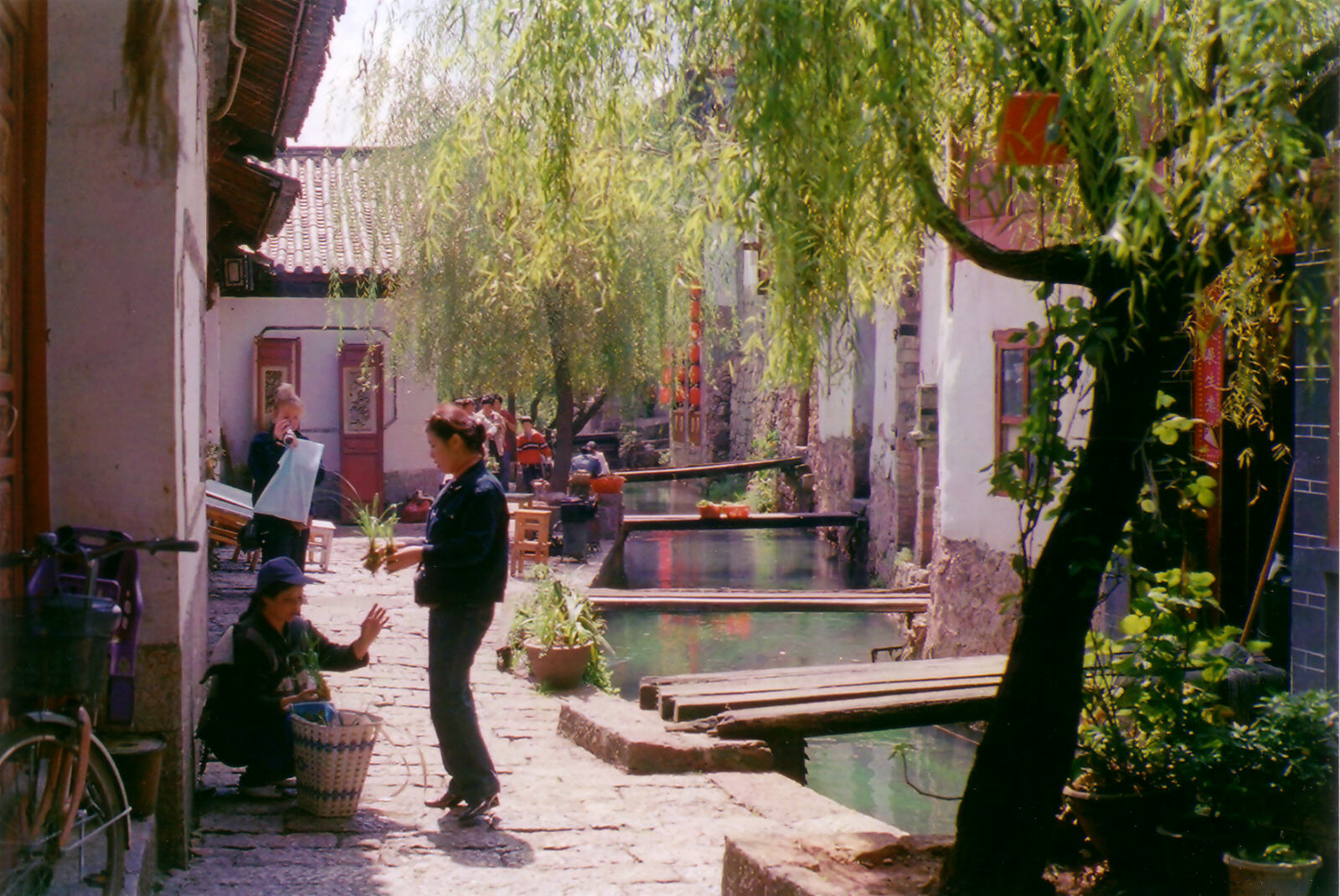
|
Most of the old houses are now cafés and shops and there is a wide range of food and drink available from Tibetan to Pizza. We strolled around in the sunshine looking at the shops and the faces of the passers-by, many of whom are the local Naxi tribespeople in their colourful national dress. In the afternoon and evening there are dances in the market square, where old folks chat while the local Naxi people perform a traditional dance around in a circle to a tune from a piper or someone with a CD player standing in the middle of the group.
|
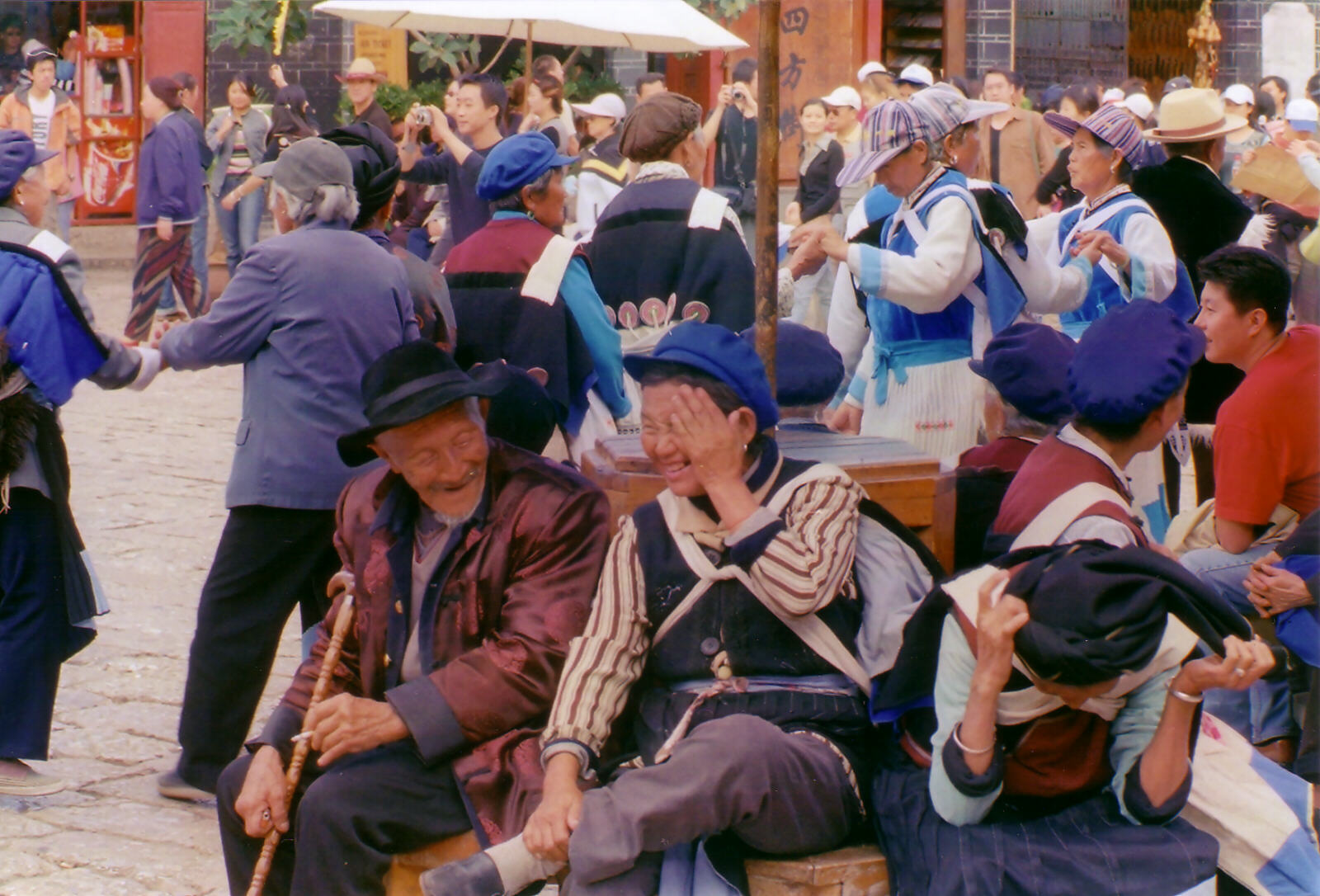
|
Beside the streams were ladies with small tanks of goldfish, which you could buy and set free in the stream (so that they can catch them and sell them again!). There are larger fish in the streams too, and we were afraid that we had just released a goldfish so that it could be a big fish's dinner, but they seem to co-exist peacefully. In the evening you can also buy little candle boats to float down the stream which gives the place a lovely flickering, peaceful effect. This is another picturesque street in Lijiang old town. |
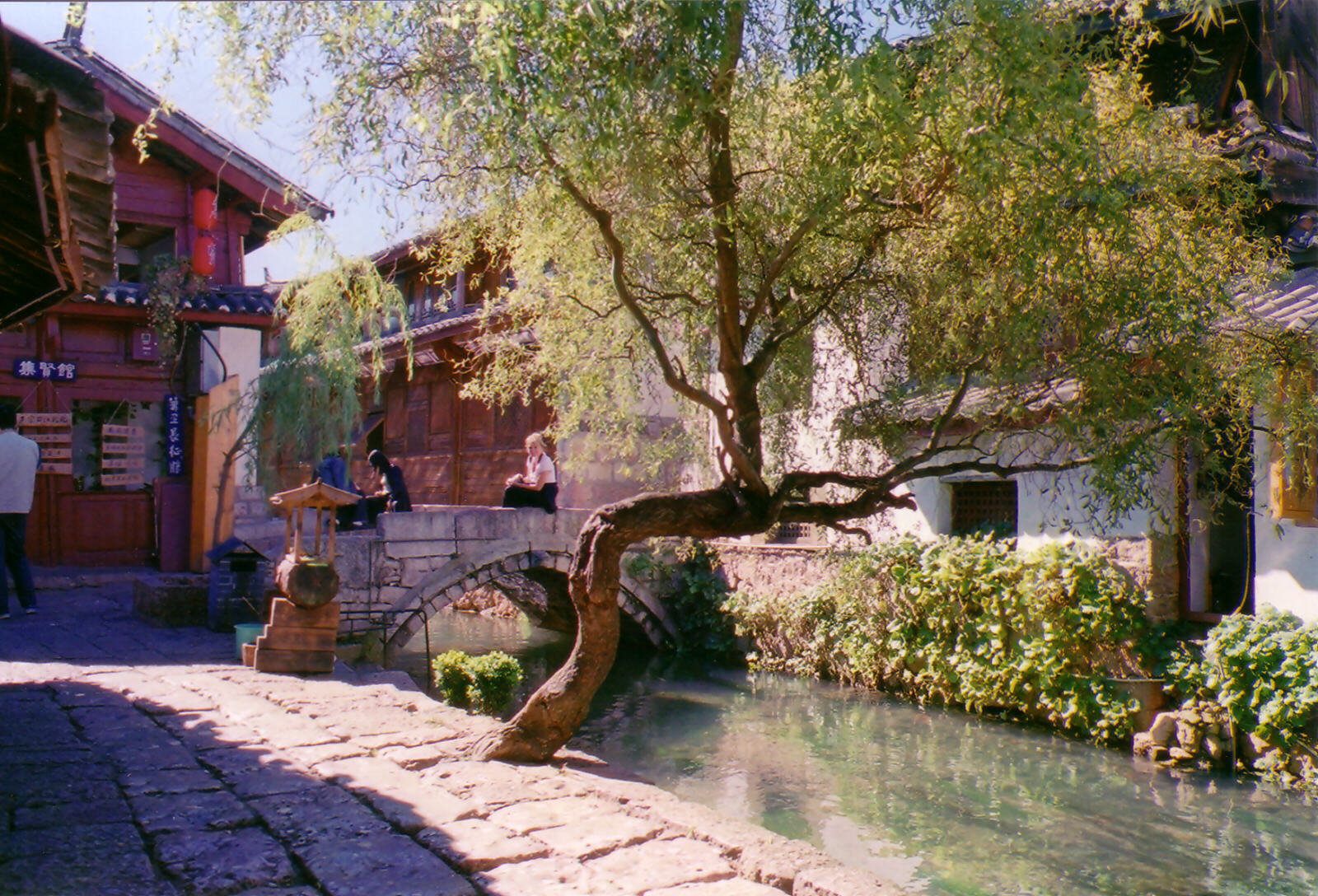
|
We climbed up Lion Hill Park to Wanju Pagoda for nice views over the old and new towns and the snow-capped mountains in the distance. We also took some more laundry to the cleaners in the new town and I had an excellent haircut nearby for Y5 (about 35 pence!).
We ate really well, stopping for breakfast at the Prague Café (omelette and pancakes), lunch at Lamu's House of Tibet (soup and a sandwich, with paint-stripper Tibetan red wine and smooth, sweet peach wine) and dinner at Mama Fu's (peppersteak, beef with green chillies and Naxi fried rice, which was far too much because the platefuls were huge). Each of these restaurants was in a wonderful position beside one of the streams that flow through the town. We also discovered the 'Well Bistro' in the old town and had long, relaxing lunches of pizza and apple strudel, with Yunnan red wine (which tasted even better here than it did in Chengdu - perhaps it doesn't travel) as we sat sleepily reading books from their library, or dinners of stir-fry beef and onion and a vegetable curry, all extremely tasty.
One day we got a taxi to Shuhe (Y15 each way), another interesting and picturesque old town on the other side of the valley a few kilometres from Lijiang. It was fascinating. The first part is a brand new 'old' town that they are building with traditional style houses all intended to be shops and restaurants. It was a hive of building activity with everything being done by hand - chipping paving stones down to size, mixing cement, cutting roof beams, etc. The real old part of town, shrinking up the hill away from the advancing tourists, is a traditional farming community with cows and chickens in the yards, corn cobs hanging out to dry and streets covered in dung. In one part of the stream they were washing clothes and just upstream, rinsing vegetables. We loved it. |
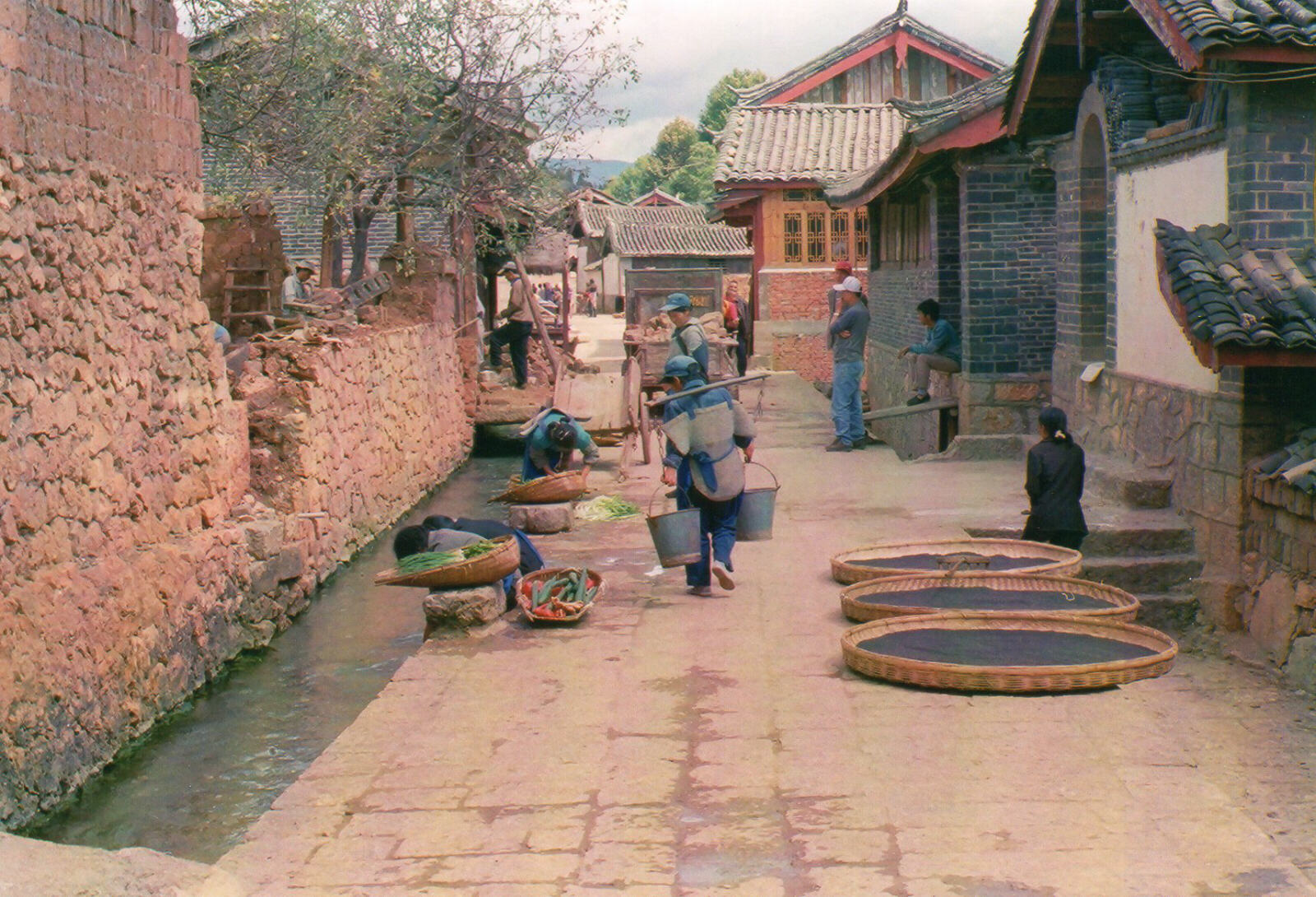
|
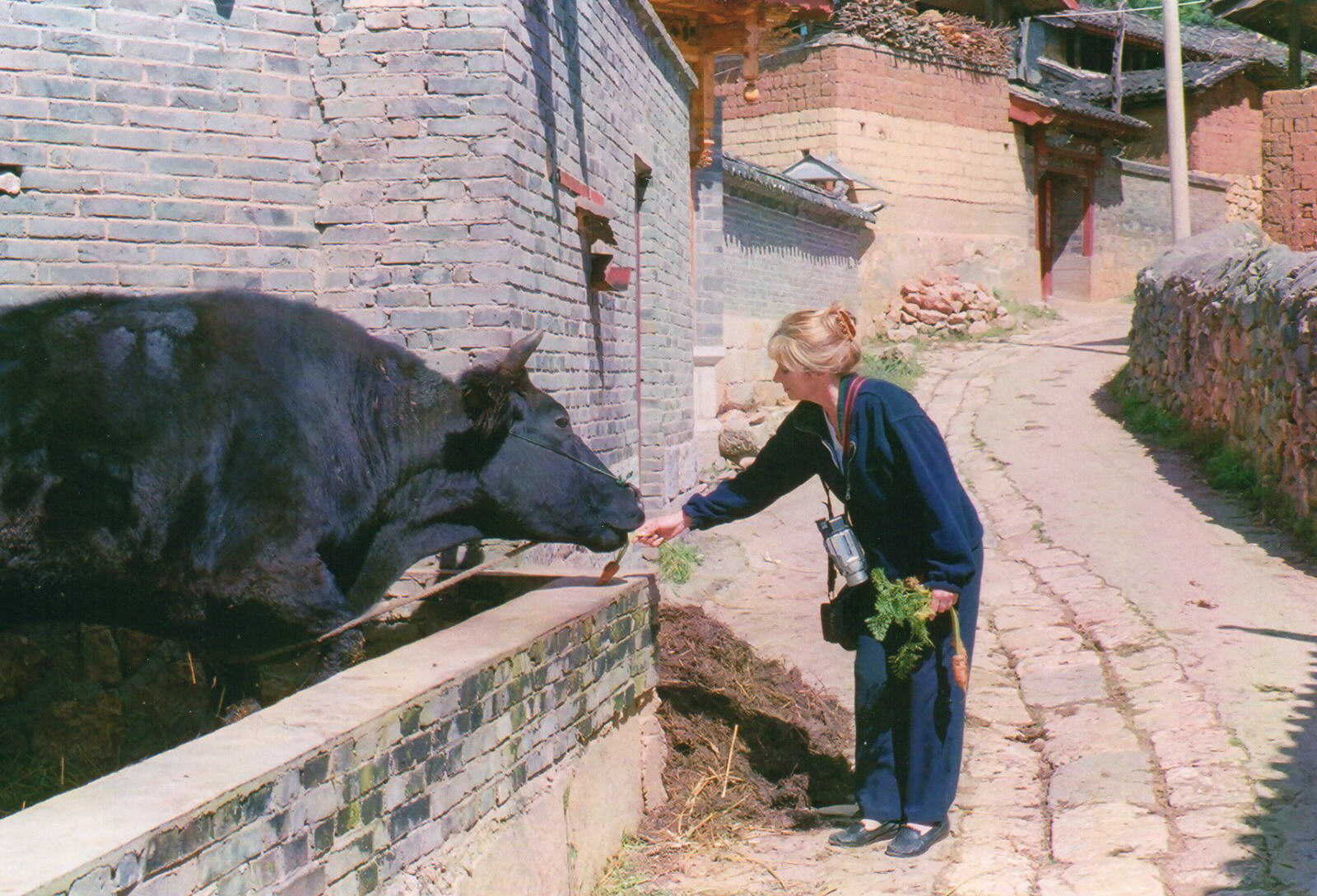
|
Dali city, Yunnan province
|
Thurs 14th to Sun 17th Oct. We bought our tickets to Dali at the well-organised bus station in Lijiang, and got the 9:30 minibus to Dali. It was a very scenic and interesting ride, and would have been quite comfortable if we hadn't had the seats behind the wheel-arch with less legroom. The journey only took three hours and the bus dropped us at the edge of the old city, where we got a taxi to the Yu Yuan guest house which had been recommended by the Israeli couple we met in Chengdu and it was a real gem. It's a modern building, next to a gurgling stream running down the small street outside. The rooms are nicely furnished with lots of space, an actual bath in the bathroom, very friendly staff, 24 hour hot water and scrupulously clean, all for Y80 a night.
Old Dali is another picturesque town with lots of atmosphere although not as outrageously photogenic as Lijiang, and we spent several days strolling around the pleasant old town and city walls. We had a look at the marble market by the South Gate, where Sheila bought a selection of heavy, decorative marble balls which she carried all the way home, then we had a walk along the restored city wall (less than a quarter of the wall has been restored and it ends at a dead end so you have to walk half way back again to find some steps to go down). The North Gate is very similar to the South Gate except that it stands in splendid isolation not connected to any wall. At North Gate we got a horse and carriage to the Three Pagoda Park and down to the lakeside to see the ferry boats. Back in town we found an unusual sheep-powered taxi. |
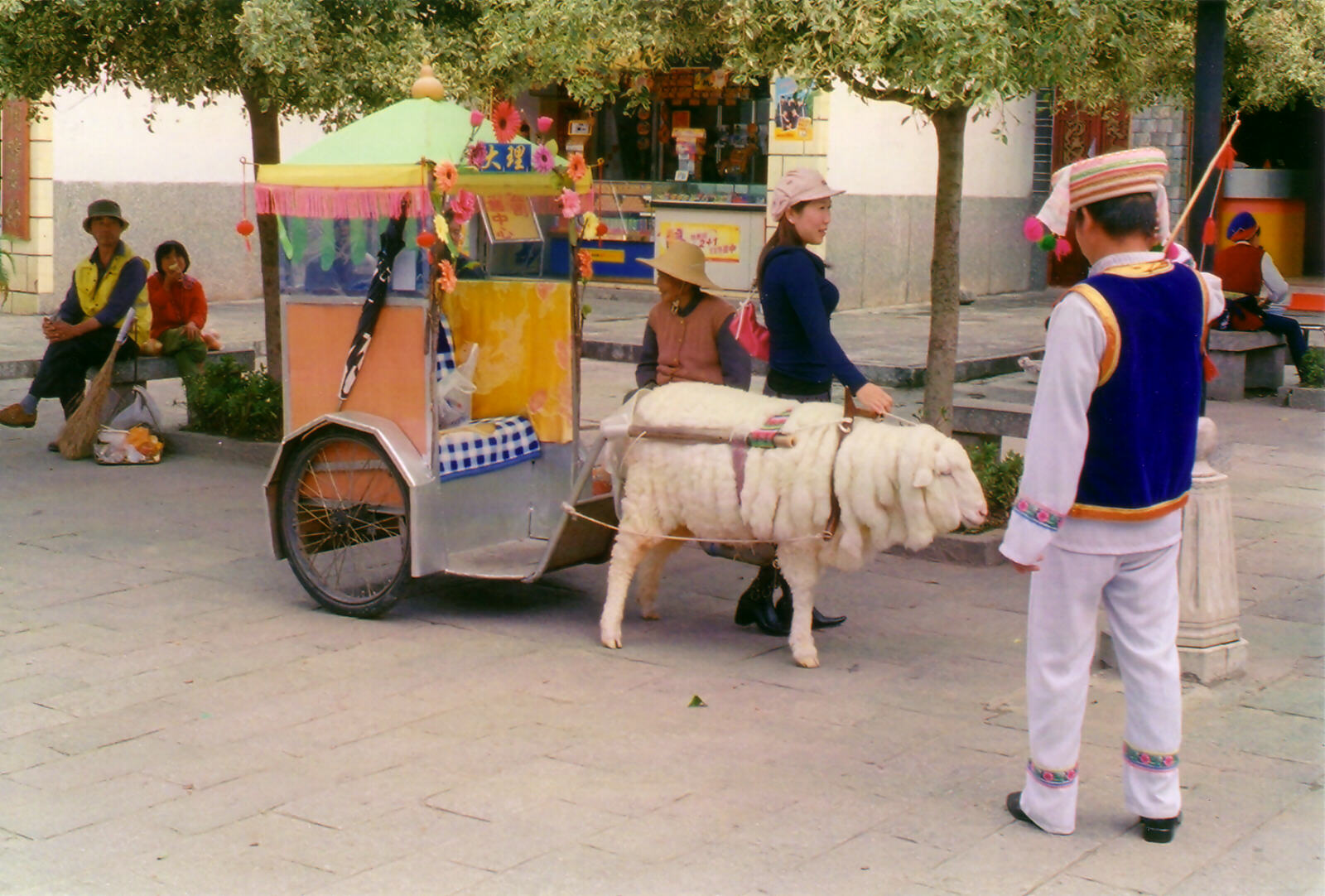
|
There are some excellent restaurants on 'Travellers Street' in Dali, including the Sunshine Café where we had a garlic steak with veg and chips, a huge Mexican burrito and of course a bottle of Yunnan red wine, because we are in Yunnan. The range of food they produce in their tiny kitchen is amazing, on another occasion we had an Indian meal there and another time a pizza. We finished off with rice pudding (Sheila's favourite on holiday). Another good restaurant was the Tibetan Café where we had a yak steak which was delicious, and 'Tibetan Triple Slam' - three eggs, sausage and bacon! The only thing still missing is a cup of China Black tea, the only sort of tea available is Lipton's. One fish and vegetables restaurant has today's menu on display in the street outside. |
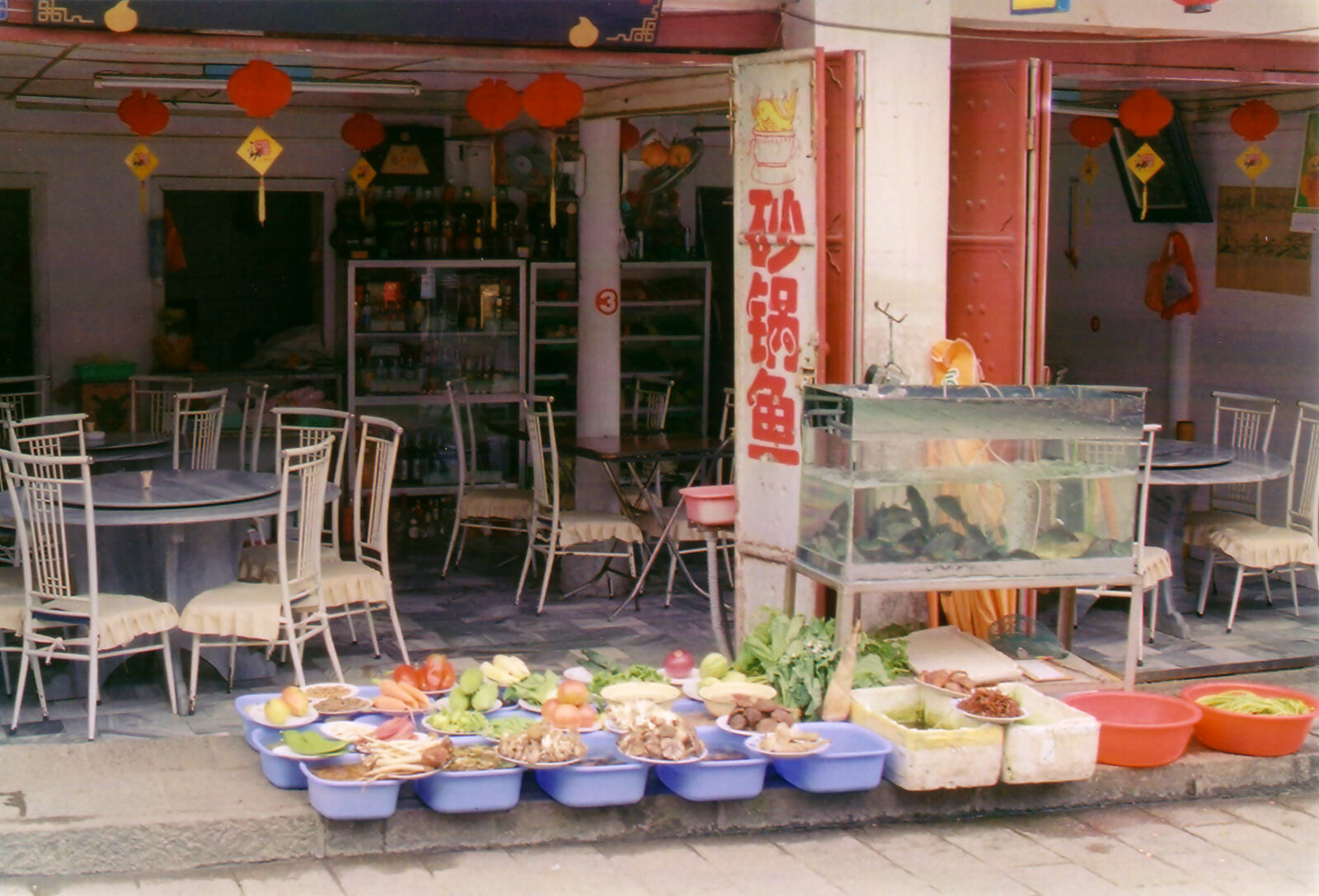
|
One day we went on a 'tour' round lake Erhai; for Y200 we had our own car and driver, and had a very nice day driving gently around, watching the timeless agricultural scenes by the road and stopping at picturesque old markets and fishing villages along the way. This lady is stacking sugarcane at a village near the lake. |
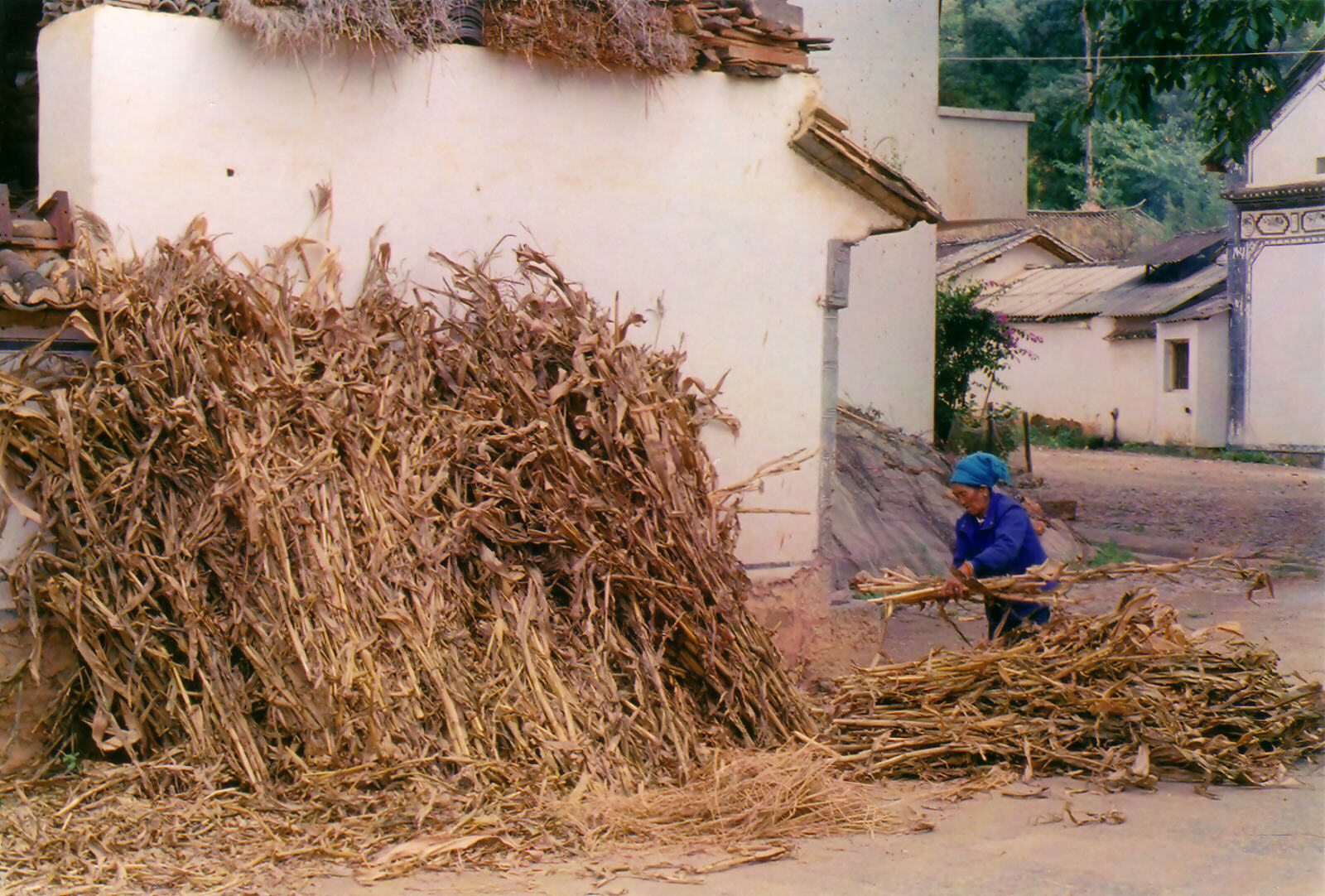
|
The market at Wa'se was absolutely fascinating as the local people came in from the fields and islands to do their week's shopping, haggling for a basketful of vegetables and a chopped-up pig's head. This stallholder is weighing out vegetables. |
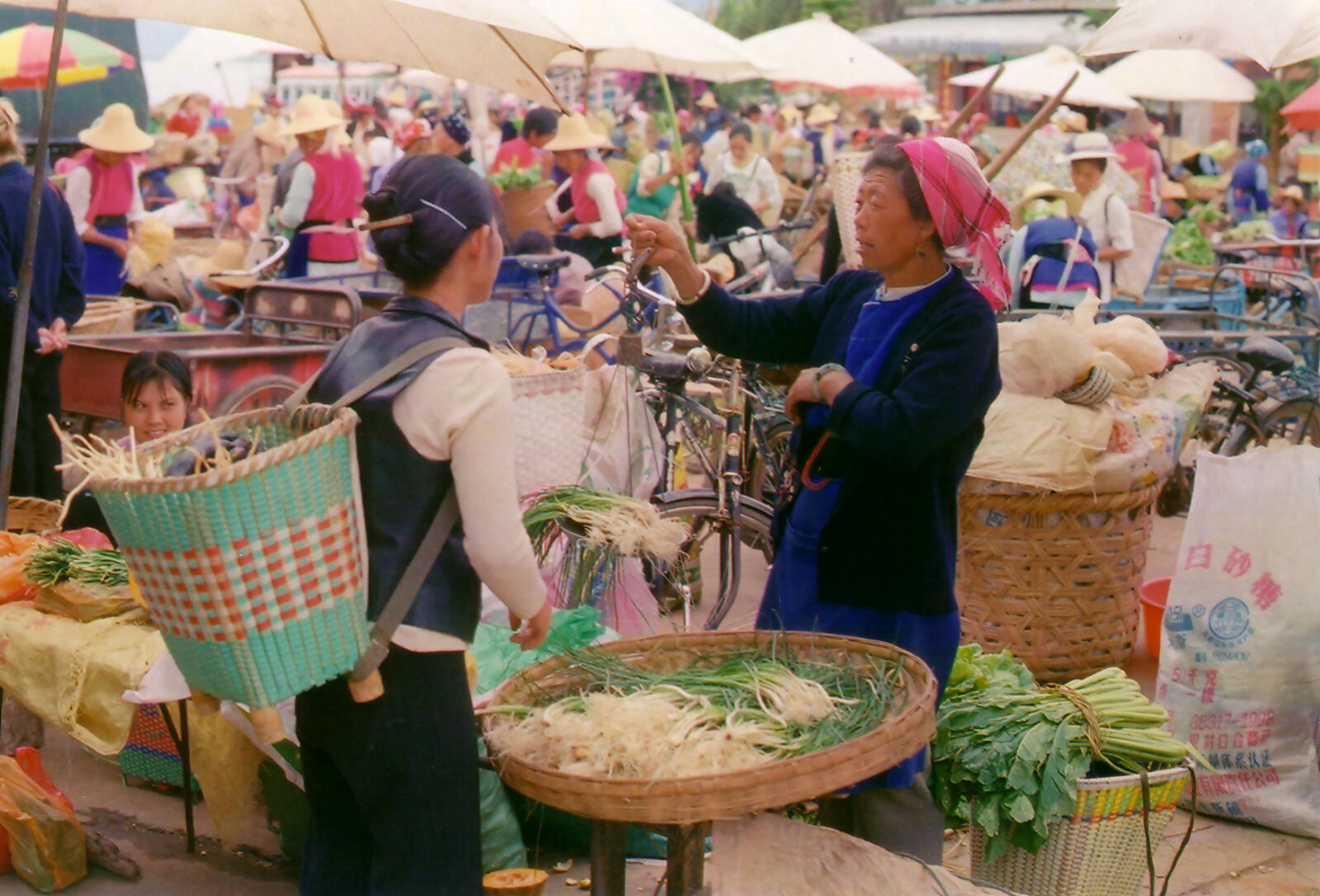
|
There was a small livestock market with pigs and chickens, and a place where you could bring your sack of rice to be weighed. This lady appears to have a single chicken for sale.
|
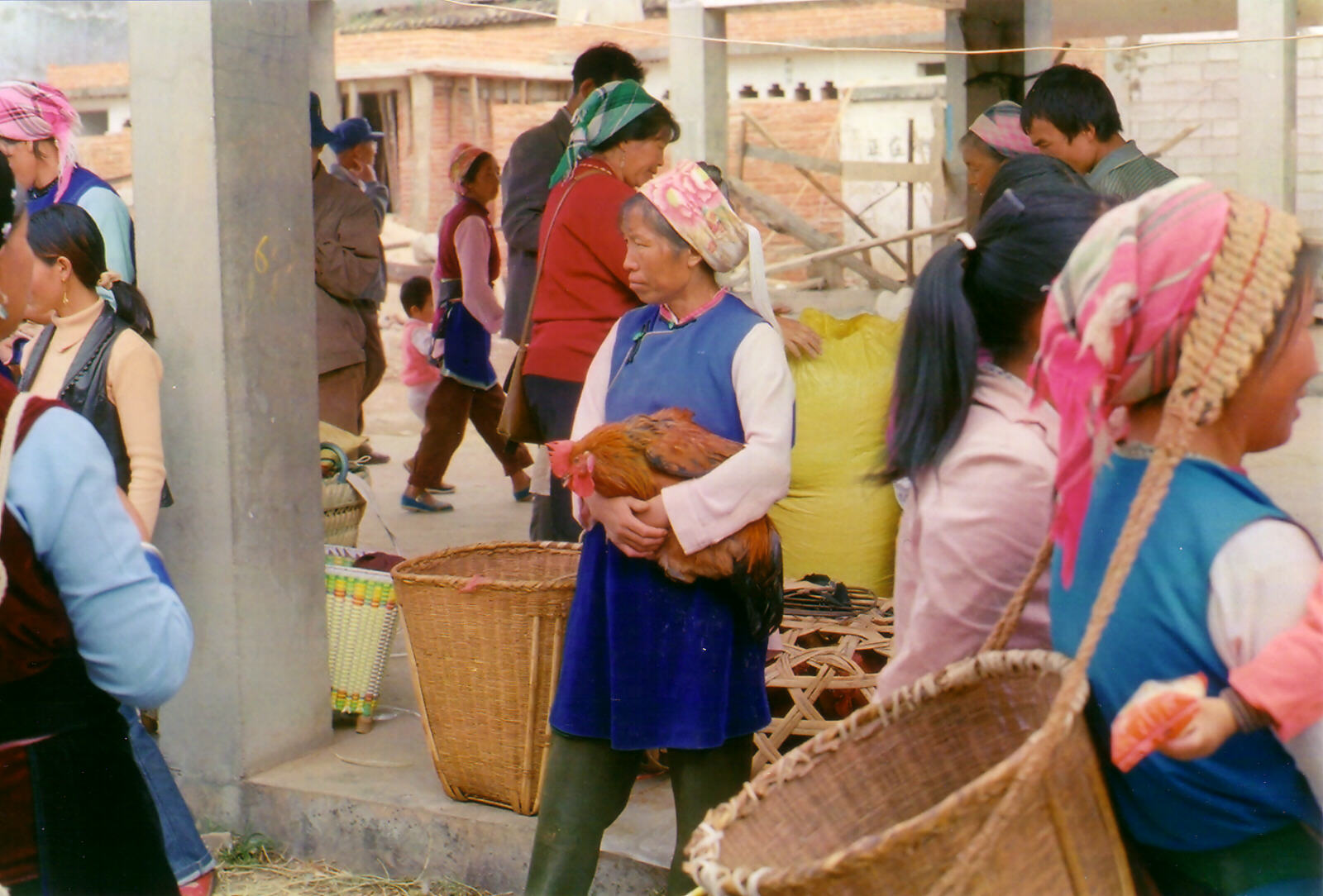
|
We also visited a tie-dye works near the lake.
|
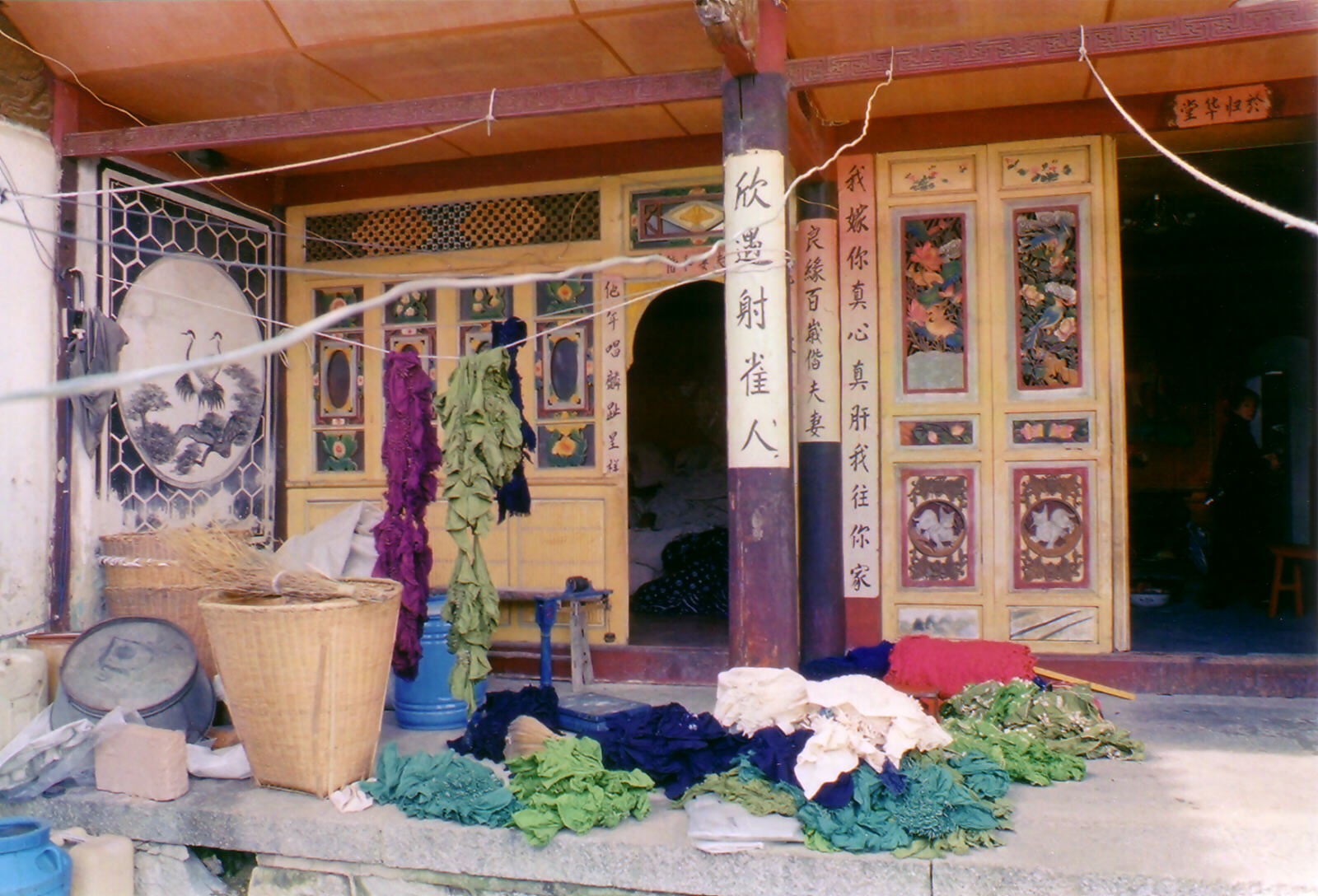
|
Our driver was really nice, the only English he knew was 'mind your head' which he said every time we got out of the little minibus, and of course I was really careful except the last time when we got back to the hotel and I banged my head! On our last day we got the taxi (the same nice man who took us round the lake) to the bus station in Dali new town, where we boarded the sleeper bus for the 17-hour ride to Jinhong. |
Travelling through Yunnan to Laos - Jinhong and Mengla
|
Mon 18th and Tues 19th Oct. The sleeper bus was quite new and clean, and the journey was cosy and great fun. Unlike other sleeper buses I've been on in China and South America, this one had enough room for me to stretch out full-length, so I was quite comfortable. There were three 'bunks' side by side with a gangway between each, and two levels - we had the front two lower bunks, one by a window and one in the middle. The lower bunks have room to stash your luggage underneath, the upper bunks have no extra space, so ours were ideal. We actually got quite a lot of sleep overnight and dozed pleasantly through the tropical Yunnan mountains until we arrived in Jinhong bus station about 1 pm. The only drawback to the journey was the toilets en route, which were truly awful. We immediately booked tickets on the bus to Mengla near the Laos border and after quickly eating our lunch of samosas from the restaurant in Dali, set off on the five-hour bus trip, which was just as picturesque winding through the valley alongside the Mekong river, but was not as much fun because the Chinese passengers were all either smoking or being sick out of the window, or both.
In Mengla a chap captured us at the bus station and took us and all our luggage on his bicycle-cart to a hotel in the main street which he said was 'very clean'. Superficially it looked OK but on closer inspection it was clear that any attempt to maintain the electrics or the plumbing stopped some years ago, and later on when the cockroaches came out to play we were even less impressed. We walked up and down the main street looking for somewhere to eat or have a beer and found nothing. Eventually a nice Australian chap who was sitting on the pavement talking to some shop assistants and a kebab vendor pointed us to a small enclosure nearby where there were three or four tables and a lady was selling beer out of a fridge. Then the kebab vendor came over and gave us each a lamb kebab on a stick and they were so nice that we bought four more and what looked like a disaster turned into a nice evening - but then, we are easily pleased!
The next day our nice cycle-taxi man came and gave us a wake-up call and then when we were ready he cycled us and our luggage up the hill to the bus station, where we got on the minibus and were off to the border, an hour's ride through more interesting mountain scenery. |
Laos - Boten, Luang Namtha and Huay Xai
|
The border crossing into Laos was very painless and immediately after the immigration office was a bank where we changed some money after waking the cashier up, then we walked down the little main street to the 'bus station' which was a patch of dirt with cows wandering around and a wooden shelter with seats in the middle. We were overwhelmed by the bustle of activity.
|
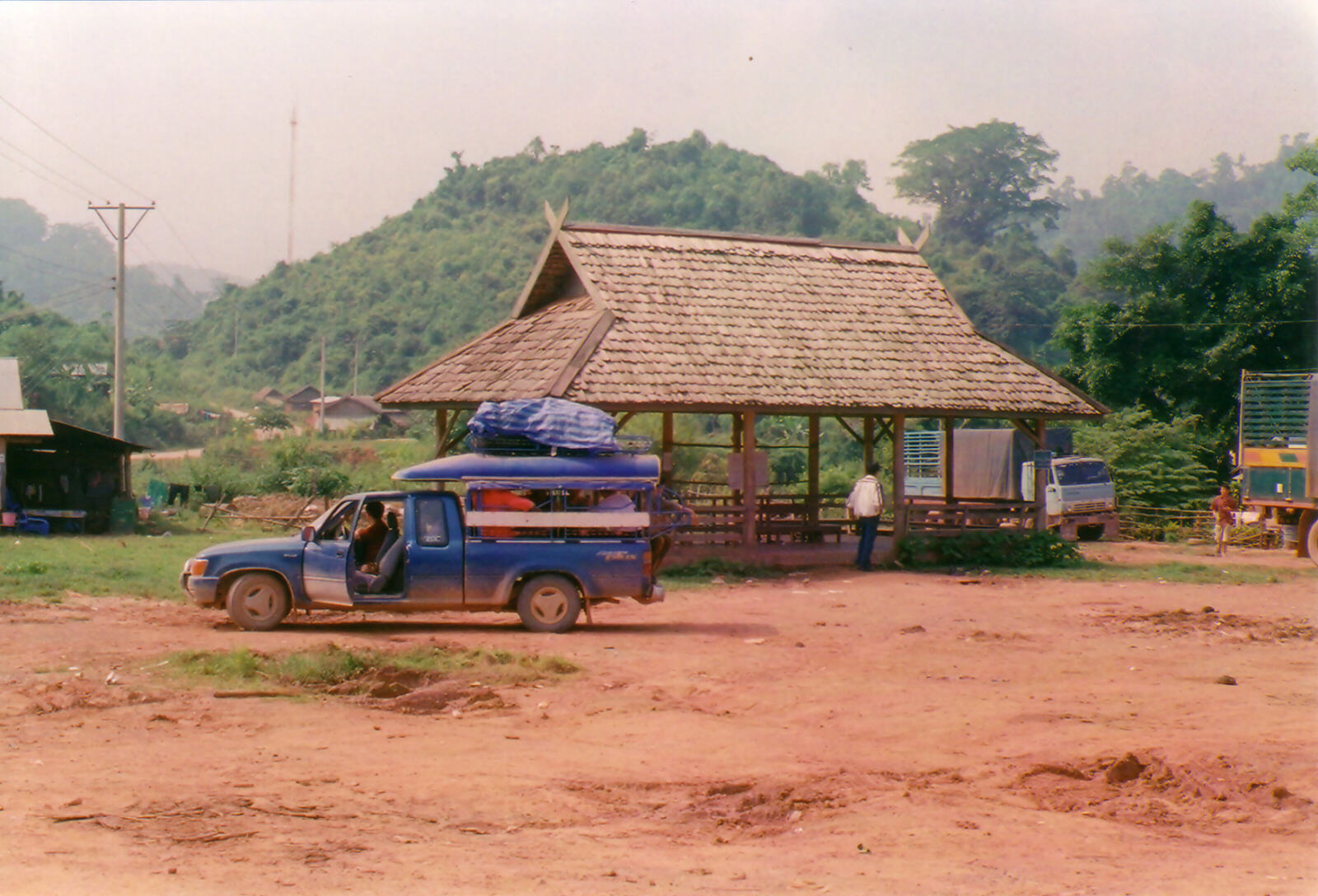
|
There are six buses a day from Boten (the little border town), three south to Udom Xai towards the main part of Laos and three west to Luang Namtha (Loo-ang nam ta) where we were going. About 11 am the 'bus' arrived, which was a Toyota pickup with bench seats in the back, and we were off for the two-hour ride to Luang Namtha. Laos has a completely different feel to China, much quieter with wooden houses on stilts and far less traffic on the road, and Luang Namtha is a sleepy little town with a few guest houses and not much else. We picked the Salkhong Longsack guest house because it appeared to be in the 'centre' of town (although there is no discernable centre, just one long dusty street) and got a nice big room for 40,000 kip (about US $4 - the money here is awful with really huge numbers - we were millionaires after we changed money at the bank). The best thing about the guest house was that right opposite was an Indian restaurant, so straight after checking in we went across the road for Lao beer and a very nice Indian meal. I then walked about a bit and established that there is not much to see, except the 'boat landing' (a set of wooden steps leading down to the river) which was completely deserted until three long boats came up and they unloaded some live pigs. That evening after it went dark we had a re-run of lunch with a warm beer and another lovely Indian meal across the road.
Weds 20th. Luang Namtha to Huay Xai.
We got down to Luang Namtha bus station (another patch of earth with a waiting place in the middle) early, which was a good thing because we found that the bus to Huay Xai (Hoo-ay sigh) was actually another Toyota pickup truck because the road is so bad that a normal bus can't make it. We tried to get the seat next to the driver rather than spend eight hours rattling around in the back of the truck covered in dust, but someone else had already nabbed it. However, a nice man in the bus station ticket office said there would be another truck in an hour or two and he would reserve us the front seat in that one. When it came in several hours later there was keen competition because several local people were hanging around trying to chat up the driver, but our man was as good as his word and thanks to him and Sheila's sharp elbows we got the front seat and one of the little seats in the cab behind the driver. This made a huge difference to the journey because the road was truly awful - it was a dirt road all the way with bumps and ruts and huge swampy potholes, so if you weren't covered in dust you were splattered with mud. We finally arrived in Huay Xai about 7 pm at a deserted bus station. Eventually a taxi turned up and took us to the Arimid Guest House which was lovely - the rooms are in little wooden chalets on stilts with a fan in the ceiling. After a shower, a beer and a nice Lao meal in their restaurant we felt human again. |
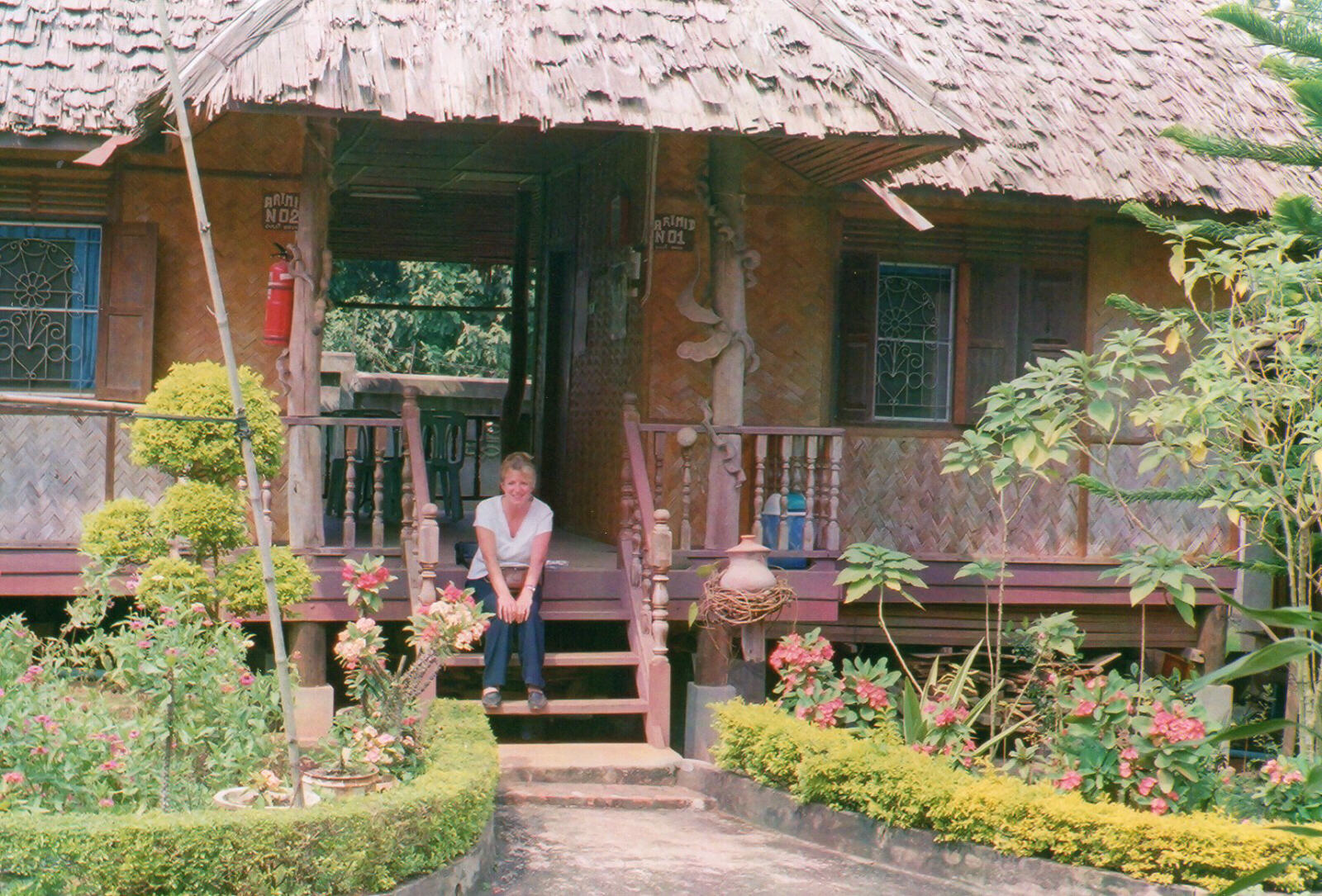
|
Thurs 21st. We decided to have a leisurely day in Laos. We walked down to the ferry landing to see where the boats go across the Mekong to Thailand. Then we strolled up and down the one street in town, and up the steps to the temple on the hill. For lunch we went to the café overlooking the Mekong and the ferry landing and had very tasty chicken lemongrass soup, pork with garlic and egg fried rice while we watched the occasional boat come and go to Thailand. That evening it was still very hot and we were too lethargic to leave the guest house, so we had a beer and a plate of spicy french fries and went to bed early. It was only later that we realised that the french fries were probably cooked in the same oil as the fried cockroaches (a Lao delicacy) that the owners were having for their dinner! |
Thailand - across the Mekong to Chiang Mai
|
Fri 22nd to Sat 23rd Oct. We were up early and walked down to the ferry landing to get the boat to Thailand. It was all very straightforward, there is an immigration office by the ferry where we were stamped out of Laos, a little bank where we changed our last Lao Kip into Thai Baht and we were on the narrow ferry boat zipping across the Mekong river to the Thai shore. Immigration into Thailand was also straightforward and we got a taxi/pickup for 20 baht each (about US 50 cents) to the other end of town where the buses leave. There is no bus station, just several separate bus offices scattered around a market, and we found that the direct bus to Chiang Mai had just left, so we were directed down a side road to where a bus to Chiang Rai (half-way there) was about to leave. This was an old rattletrap of a bus with so much play in the steering that the driver had to make half a revolution of the steering wheel before the bus even started to change direction, but it got us there and we booked a modern, air-con bus to Chiang Mai. We had an hour to wait so we went to a Continental Café just opposite the bus station for coffee and ham and cheese sandwiches for lunch. Just down the road I changed some money at an exchange booth which was between a Boots Health and Beauty shop and an Adidas shop - the change from Laos and China is dramatic!
The air-conditioned bus ride to Chiang Mai was very smooth, but unfortunately the sky was overcast and it had been raining so the view was not so good. It seemed strange to see the fields empty of people after they had been so busy in China, yet there is just as much rice. We rang ahead and booked the Sumit Hotel which was quite centrally located but modern and quiet, then after we had checked in we had a walk round and were forced to choose between - what else? - an Italian restaurant and an Indian restaurant for dinner. We chose the Indian which was extremely good - we over-ordered as usual, but thoroughly enjoyed it and because the Baht is around 70 to the Pound it was great value at about £5. We spent the next day looking round Chiang Mai with temples, second-hand bookshops and of course plenty of food - pizza and spaghetti carbonara for lunch, then in the evening we went to the night market where there is a food court with lots of different Thai or Indian food stalls as well as beer and tea, while we watched a free Thai dancing show. There was an elaborate Naga stairway at Wat Chiang Man. |
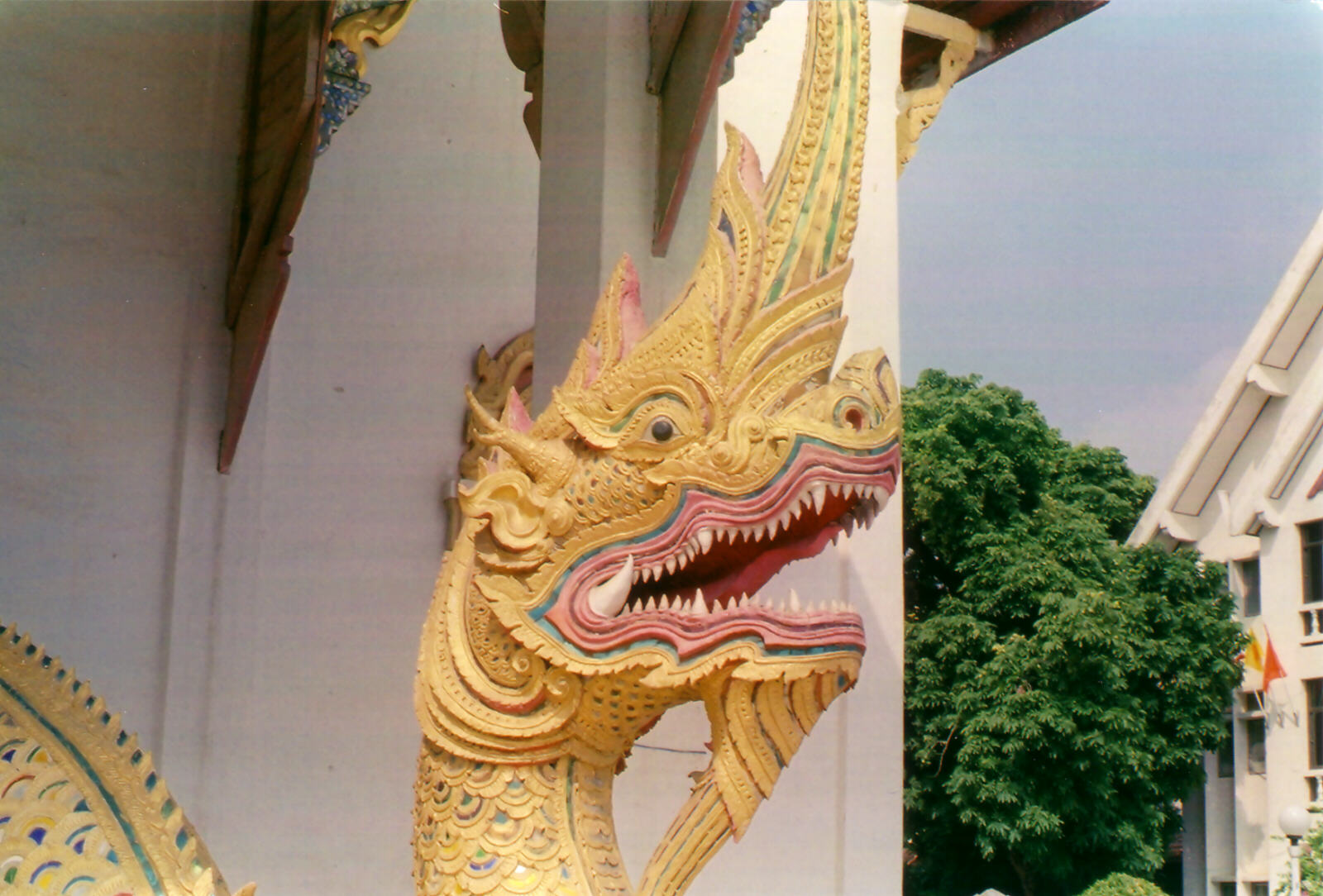
|
Sukhothai, Thailand
|
Sun 24th Oct. We went to the bus station and got the air-conditioned bus for the five-hour trip to Sukhothai. The bus ride was comfortable and we were just dozing at what we thought was one of the intermediate stops when Sheila got off to buy some food at the bus station and found that we had arrived! Apparently the bus didn't terminate there and it was just about to set off to somewhere else so we scrambled off in a panic! We went to the Garden Guest House which is lovely, the rooms are separate little wooden bungalows in a tropical garden with lots of orchids and the sounds of jungle all around; well, the less threatening sounds like birds and crickets, not tigers and monkeys. We had a short walk round Sukhothai town which is quite a small place, and found the wonderful Dream Café which is furnished with nice old wooden tables and chairs and has cupboards of antiques and artwork around the walls. We had Thai food which was excellent.
Just outside Sukhothai town there are lots of terra cotta works, turning out very attractive pots and garden ornaments. We went to one and were tempted to buy all sorts of stuff, but managed to resist the temptation this time - Sheila says she won't be able to resist next time! In the evening we went to what looked like a night market but turned out to be a sort of Buddhist fairground. In the grounds of the main temple in town were all sorts of stalls and fairground games and rides, and also several 'Buddhist booths' where the monks were shouting over loudspeakers to whoever came to sit in front of them. The noise from all of this was appalling and there were swarms of midges and mosquitoes attracted by the bright lights, so we couldn't wait to get out of there and go back to Dream Café for another great Thai meal of 'Sukhothai fondue' flavoured with pak chi (coriander).
Mon 25th. Next morning we hired a little motorbike (well, a large scooter) from the Garden Guest House and 'did' the Sukhothai Historical Park, which is about 12 km away. It was one of the previous capitals of Thailand and is full of really impressive and picturesque temple ruins and Buddha figures surrounded by moats and lakes. It was a great way to see the historical park, zipping about from temple to temple on the motorbike as the fancy took us. Among many others we visited Wat Mahathat (below) and Wat Trapang Ngoen (below that). |
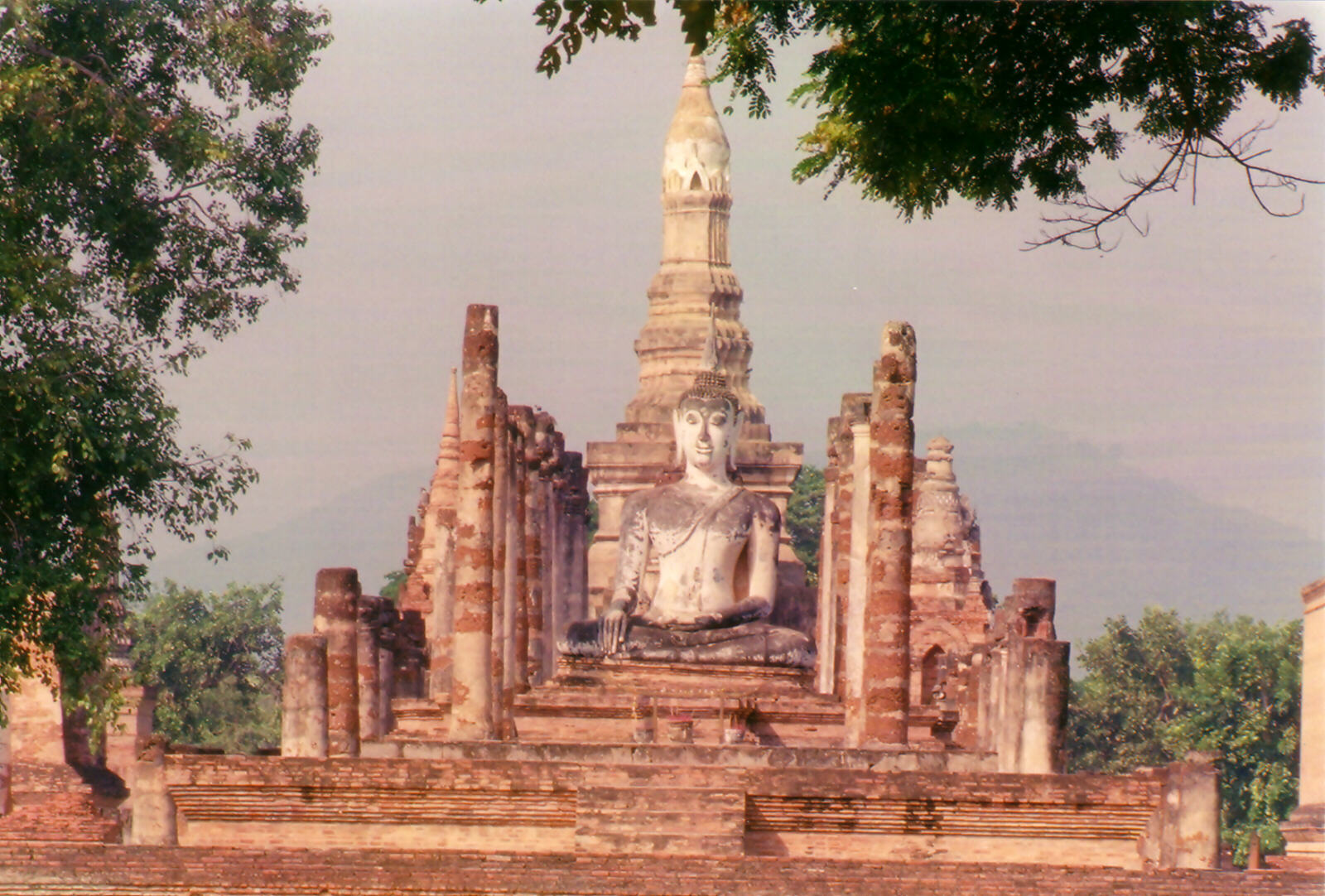
|
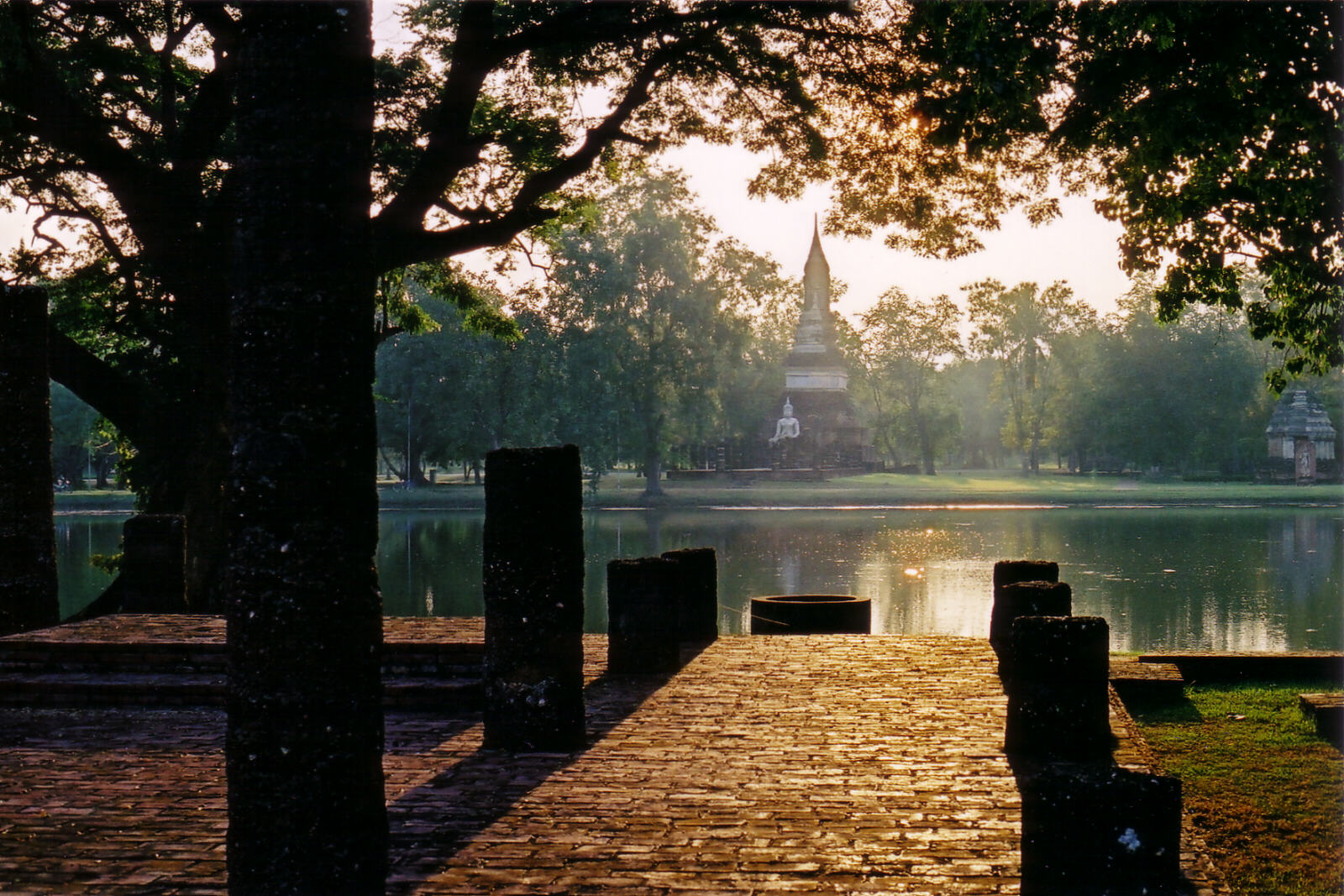
|
We came back to the guest house for a snooze in the heat of midday then went back to see some of the outlying temples, ending up at Wat Saphan Hin as the sun went down, on a western hill overlooking the valley with the rest of Sukhothai below. It was great fun. |
Bangkok
|
Tues 26th to Sun 30th Oct. After a leisurely breakfast at Garden House in Sukhothai we went to the bus station on yet another kind of tuk-tuk with the driver at the back and us in the front, and got the luxury air-conditioned bus for the six-hour journey to Bangkok. The 264-baht ticket (under £4) included a voucher for lunch when we stopped half-way. We had tried to get a room at the Royal Benja Hotel on Sukhumvit Road, a very nice hotel where we had stayed before, but it was fully booked (as were many of the hotels in Bangkok for some reason) so we got into the Royal Park View hotel a little further down the road, but still handy for all the hundreds of restaurants and bars along Sukhumvit Road, and near a Skytrain station - the only way to get around and avoid the traffic-clogged streets below. This hotel was not bad for £20 a night including breakfast, but the cleaning staff could have done with a refresher course as it was a bit grubby and tatty.
We had a few days of shopping and pampering - Sheila had her nails done, legs waxed, etc. etc., then hit the Siam Shopping Centre and Central Department Store and shopped them out. Armed with her purchases we got the Skytrain back to Asok station near our hotel, collected the laundry, collected the shirts that I'd had made and arrived back in our hotel room under a pile of possessions. In the evening we headed to the night market at Lumphini where, after more shopping, we had beer and 'starters' in the food court - some spicy sausages and five huge barbecued prawns (each one was about six inches long). A couple of cats came and enjoyed the bits of the prawns that we didn't eat (shells, heads, legs, etc.) and then we went back by metro and Skytrain to Nana Street and our favourite Akbar Indian restaurant, which was still as tasty as we remembered from our last visit to Bangkok four years ago.
One day was a four-meal day! The first was the free breakfast in the hotel, not very exciting. Second we had an early lunch at the Drop Inn just down the road from our hotel - the Drop Inn is a very nice, well-furnished small hotel and also an Italian restaurant where we had a plate of salami and a Caesar salad, which was very nice but rather expensive. Then at teatime in one of the many cafés on each floor of the Central Department Store (there was only one café in the basement when we first went there 24 years ago) we had a soup and a sandwich, then finally back to the evening market at Lumphini and in the food court there we had an odd mixture of Thai dishes and a Greek kebab, while a pop band were blasting out some sort of disco music. Another day we stopped at a hostess bar on Nana street for lunch of beer and peanuts and loud but good music. We got talking to an Australian chap and two of the Thai girls who worked there, and while Sheila quizzed the girls about their working hours and the services they provided, one beer followed another until we eventually staggered out after 7 pm! In good British tradition we followed the beer with a curry at the Akbar restaurant.
As a break from the shops we went for a walking tour of Bangkok; well, walking, metro, Skytrain, riverboat, tuk-tuk and taxi. We got the brand-new underground metro line which conveniently passes quite close to our hotel, down to the end of the line at the central railway station, which is all very clean and well-organised now and with lots of police around to deter the pickpockets. We walked from there through the streets and back alleys of Chinatown .... |
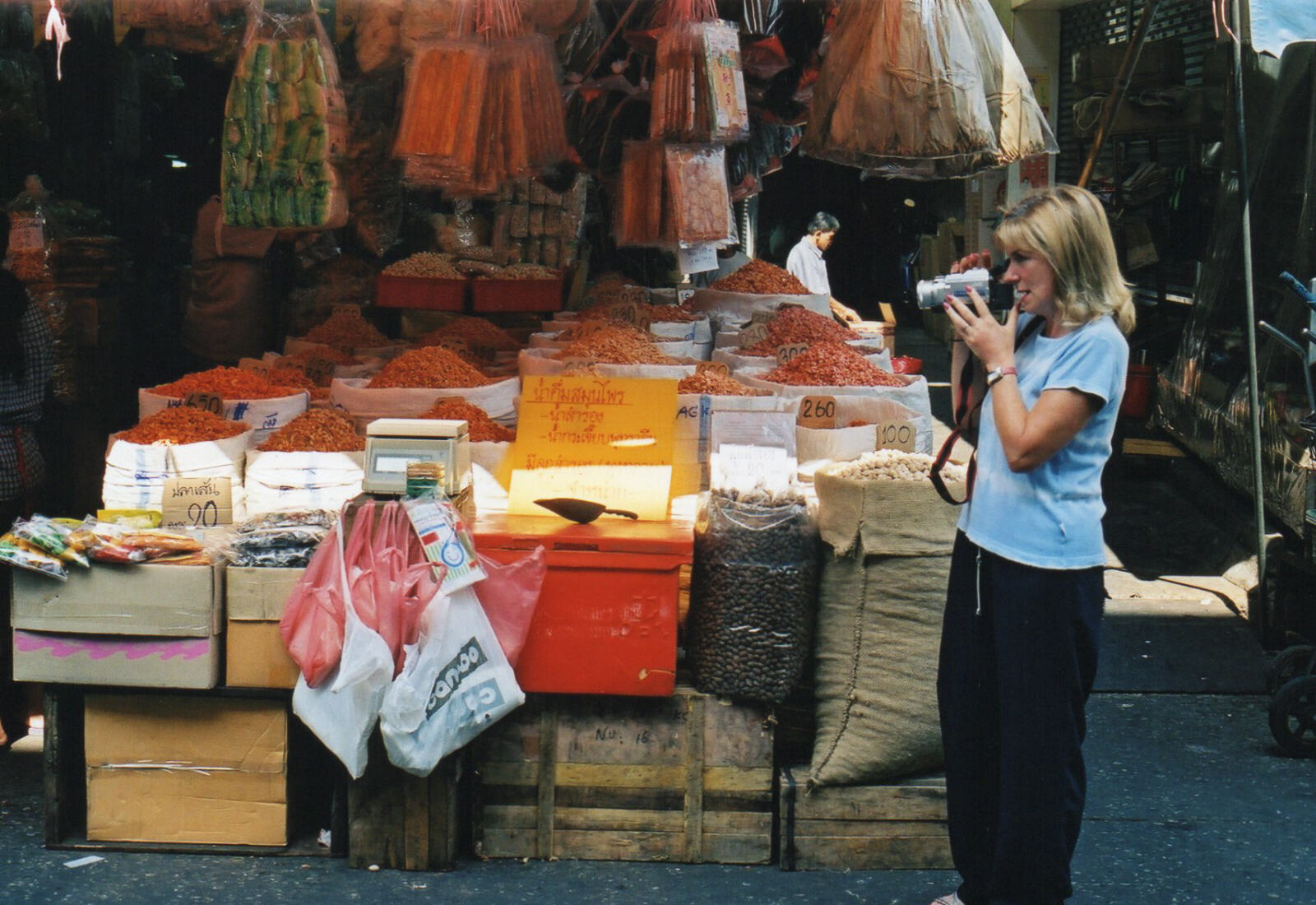
|
.... and had a look at the lively and smoky Wat Mangkon Kamalawat temple, ending up at Ratchawong pier where we got the riverboat one stop down to Si Phraya pier. This is now the location of a big, new Sheraton hotel and the 'River City' trendy and expensive shopping complex. We walked back upriver to the Riverview Guest House which is a nice guesthouse with indeed wonderful river views from the higher rooms, but unfortunately in a rather unpleasant area, surrounded by small streets with motorcycle repair shops and scrap merchants.
|
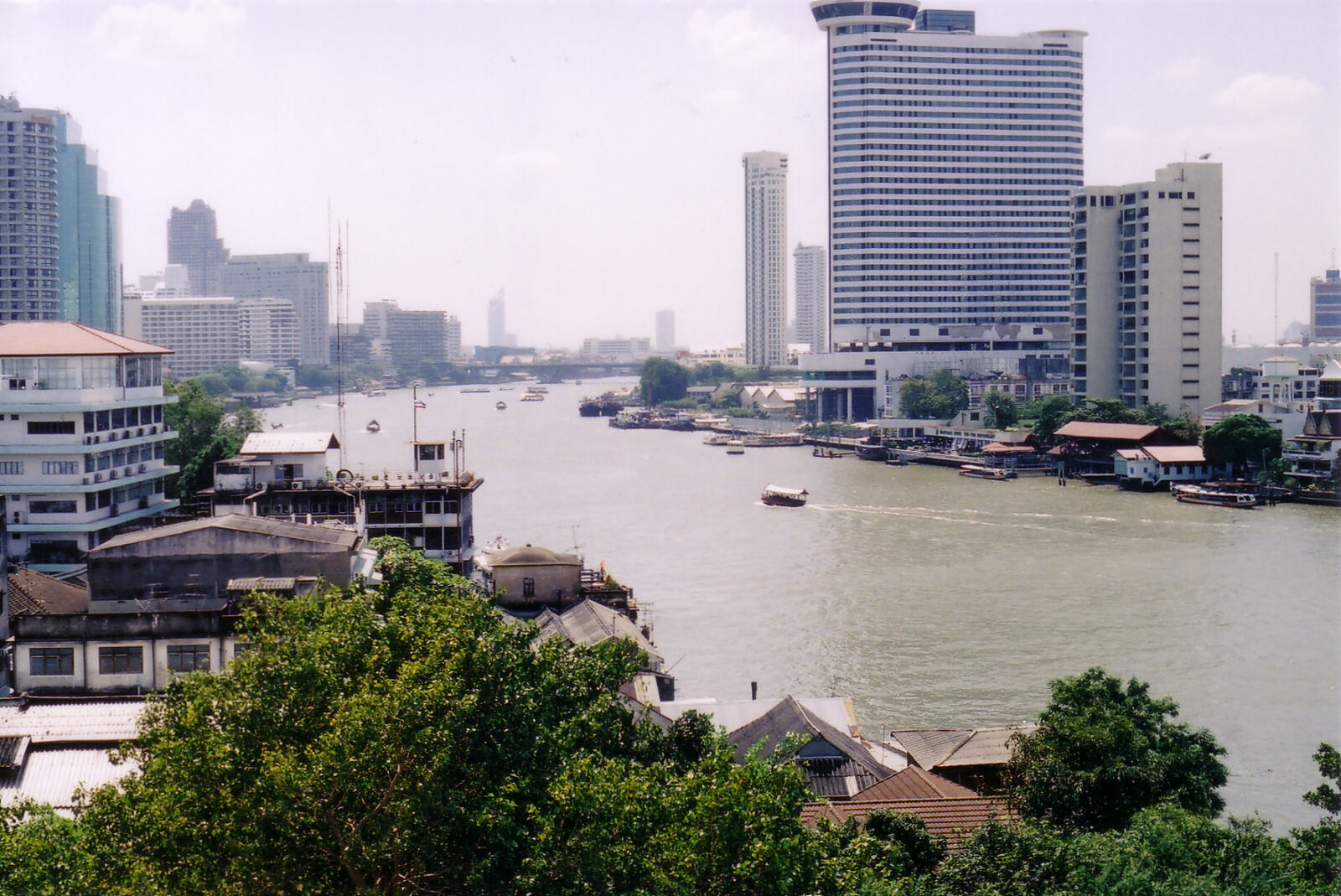
|
We hoped to have a cup of tea on the top-floor restaurant of Riverview but it was closed between 11am and 6pm so we got a tuk-tuk down to the Oriental Hotel and went and sat in the lovely old Author's Lounge. Here we had an 'afternoon tea' complete with cakes and sandwiches and Earl Gray tea, served in the wonderful atmosphere of one of the 'grand hotels' of the East. It was expensive, but because it was breakfast, lunch and tea combined for us it seemed like good value. |
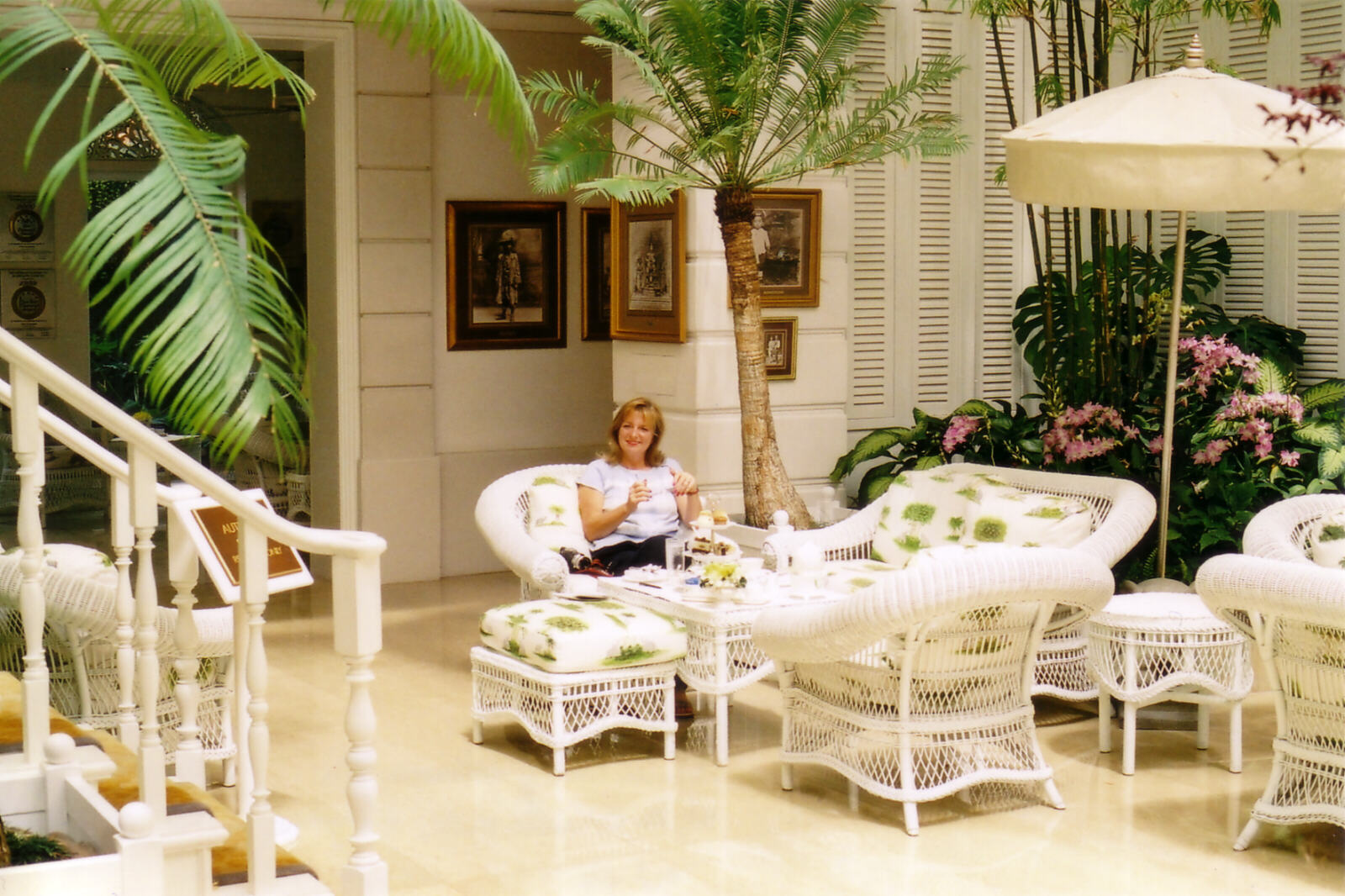
|
Then we got the riverboat again from the adjacent Oriental Pier one stop down to Sathon Pier, where the pier connects directly with the terminal of the Skytrain line, so we only had to walk up some steps and we were on the train back to Siam Shopping Centre. On our last day we went to the weekend market at Chatuchak, which was a huge, crowded, hot, sweaty place and we eventually retired exhausted and went to have a very nice Creole/Cajun lunch at Bourbon Street Bar. We had paid extra for a late checkout at Royal Park View hotel so we went back to the room to cool down and clean up, then we managed to persuade a taxi driver to take us to the airport on the meter (160 baht plus 70 baht motorway toll) instead of the 400 baht fixed price that they usually ask for. We flew back to London.
Finally, some words of wisdom on a shop in Beijing, which probably translates as 'You are what you wear'. |
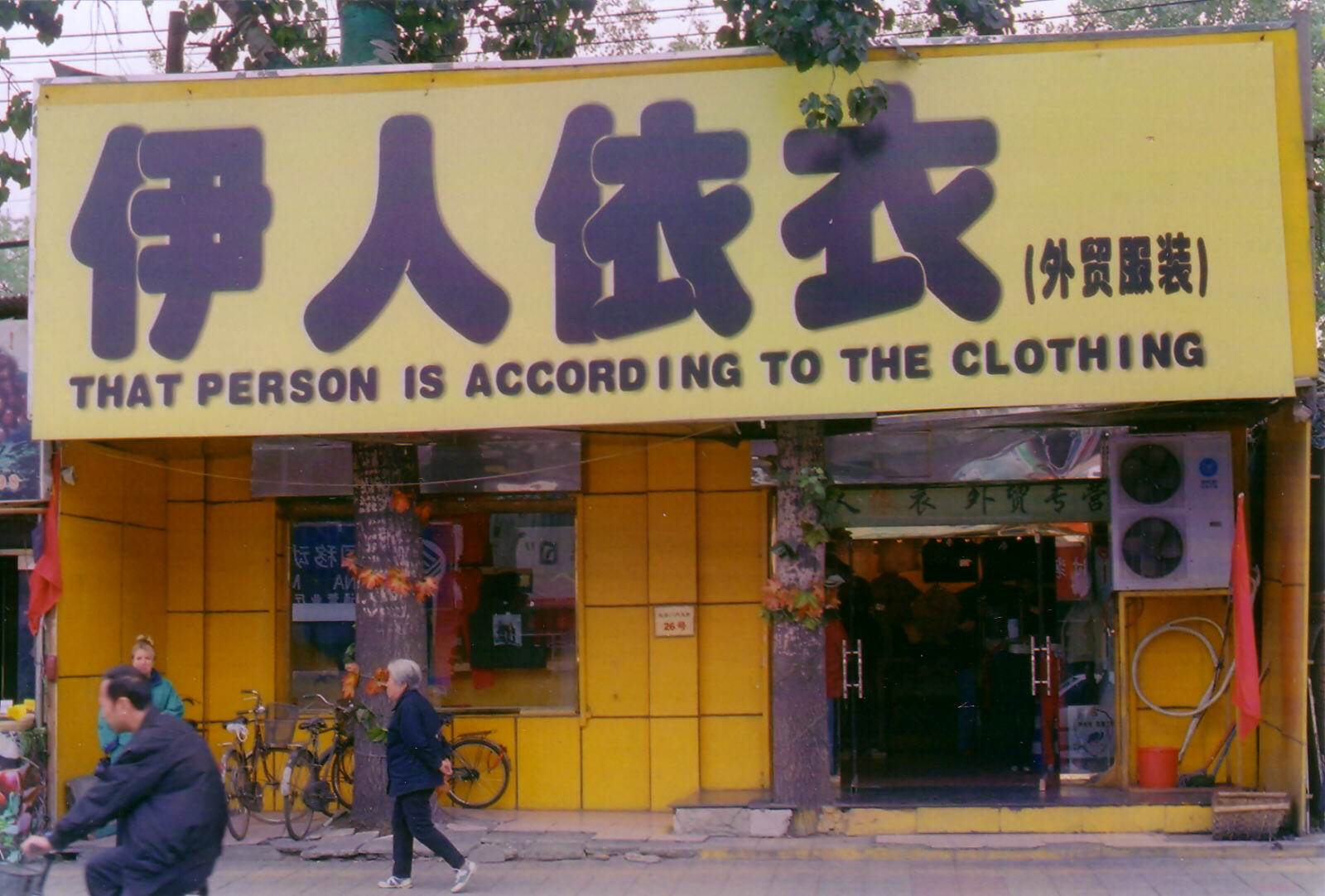
|
Back in 1980 we 'continued' this journey by train from Bangkok to Singapore,
and next year (2005) we went from London to Beijing by the trans-Siberian railway,
to complete the whole London to Singapore overland route.
If you would like to read about those or see more of our travels just click the map.

|